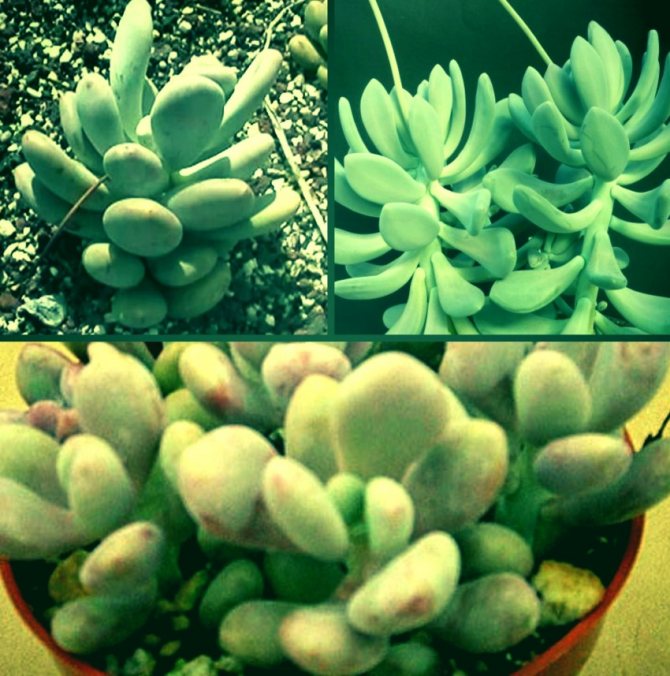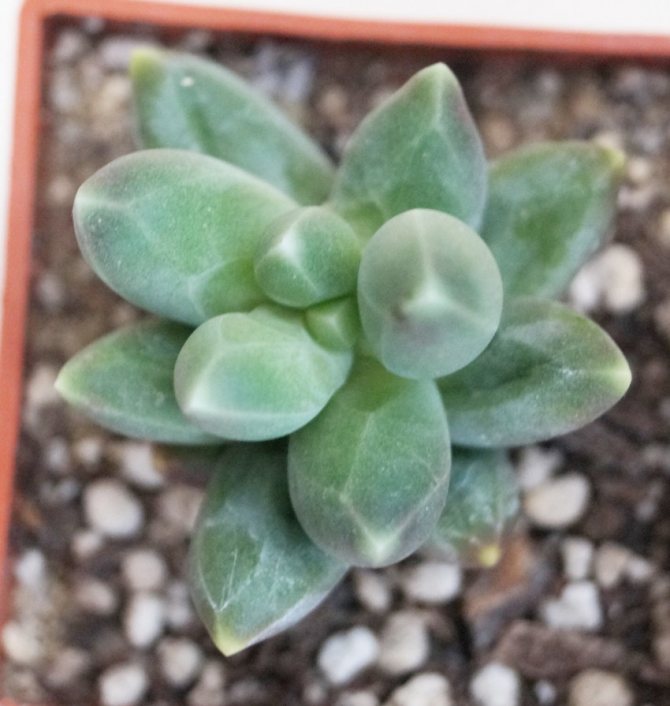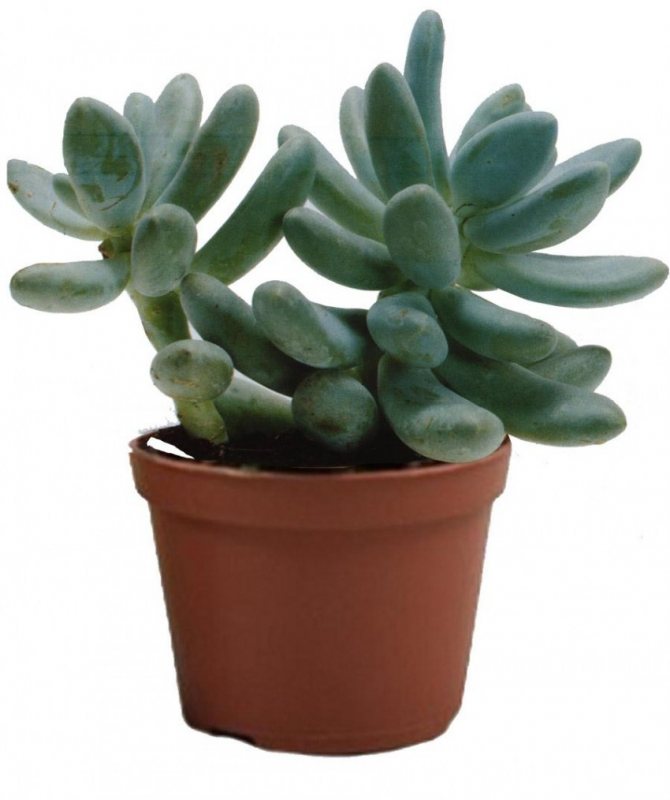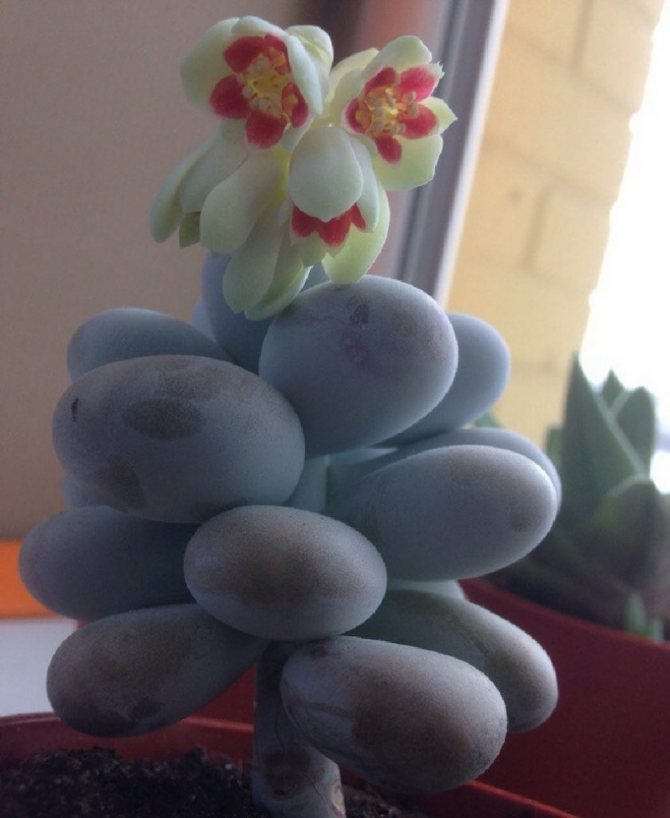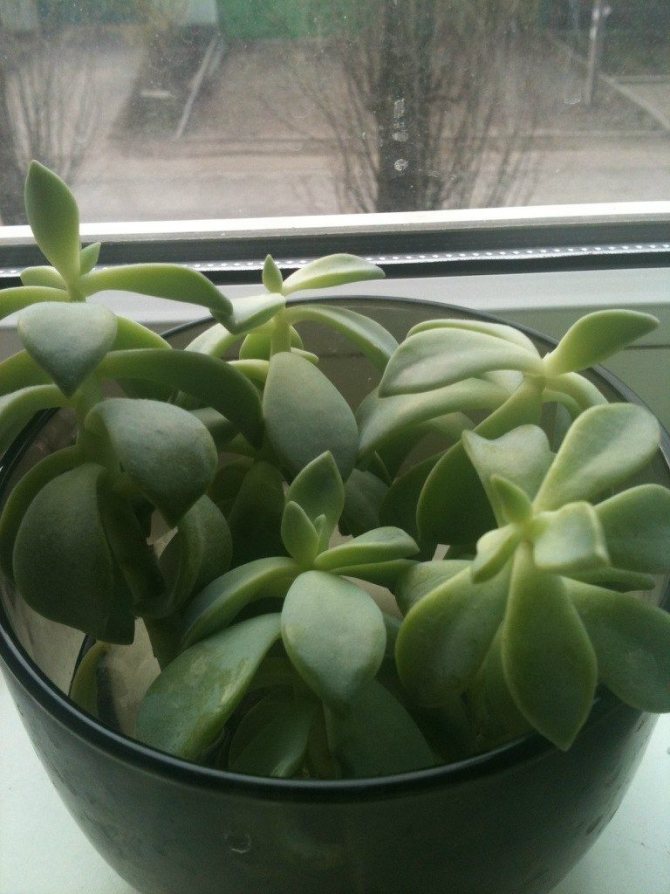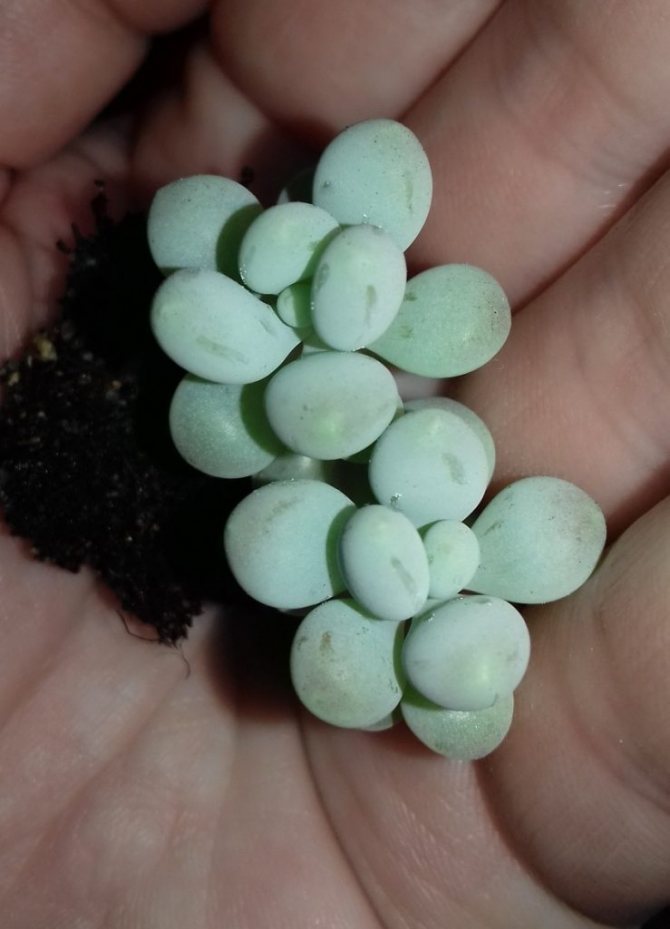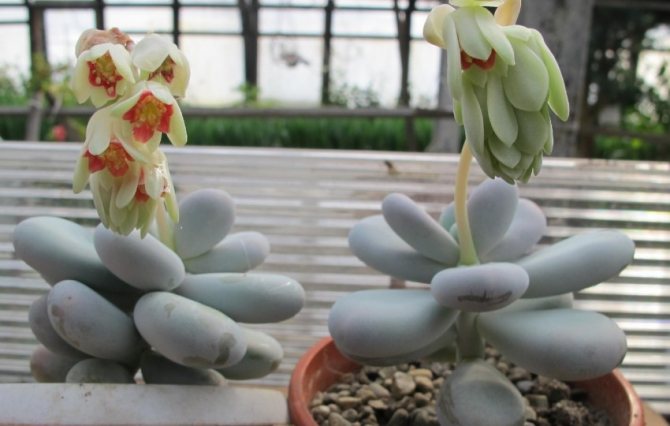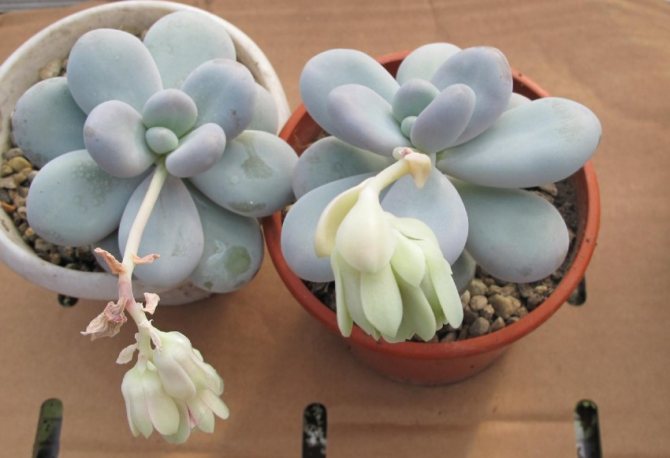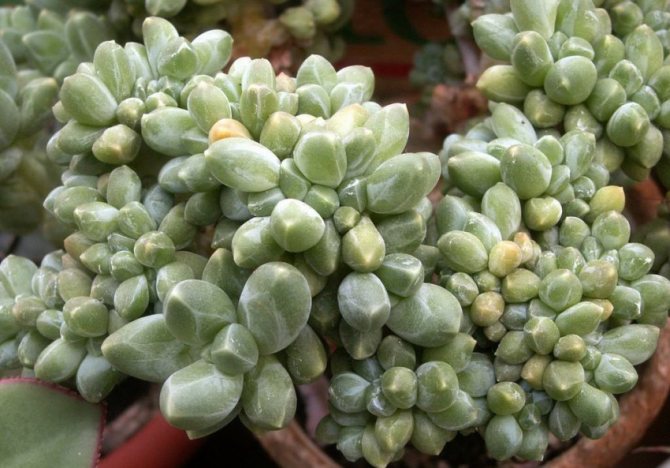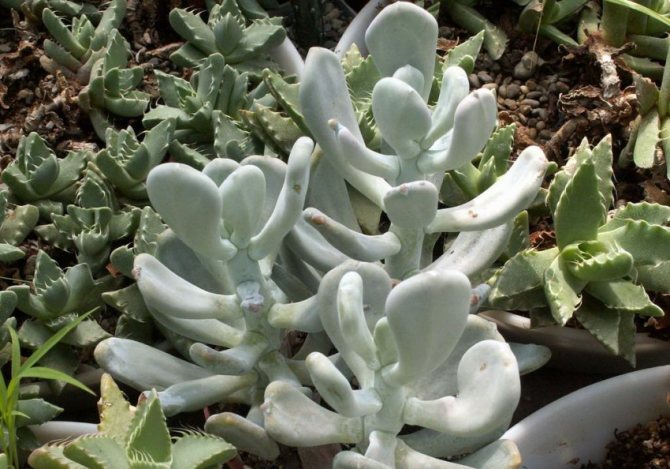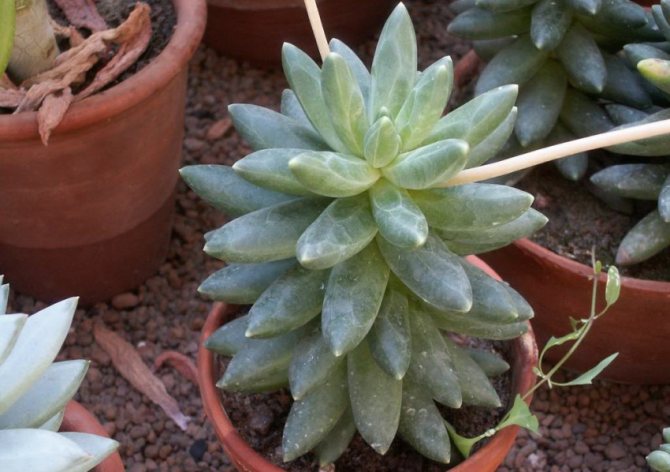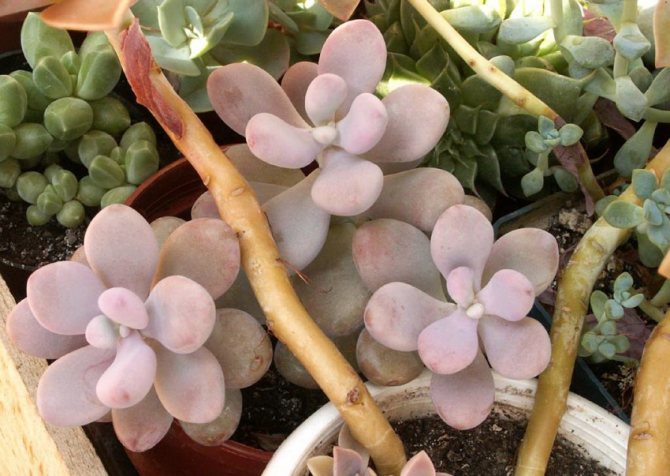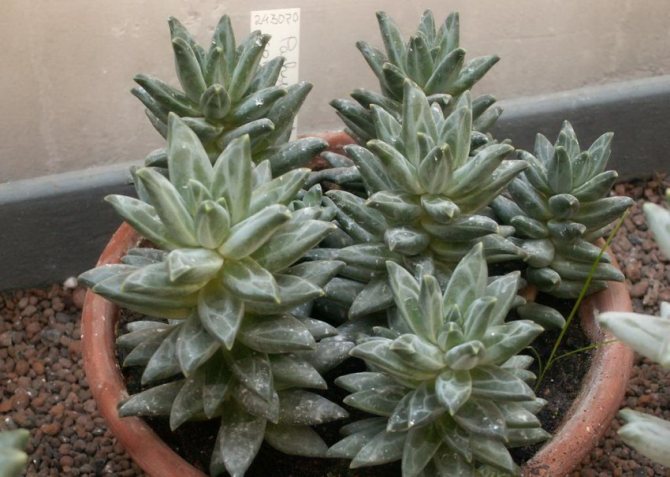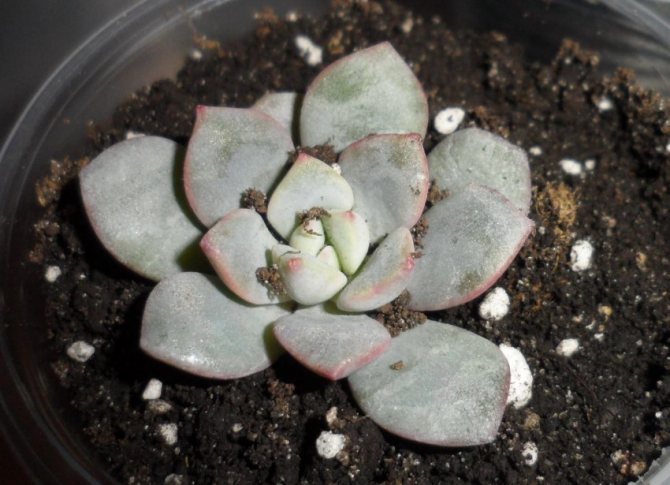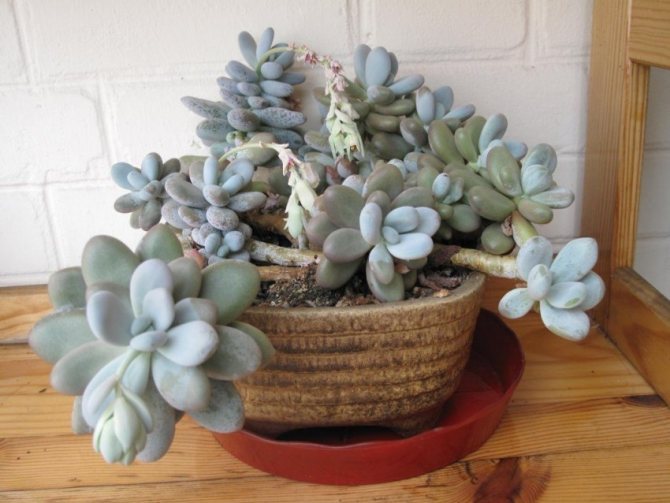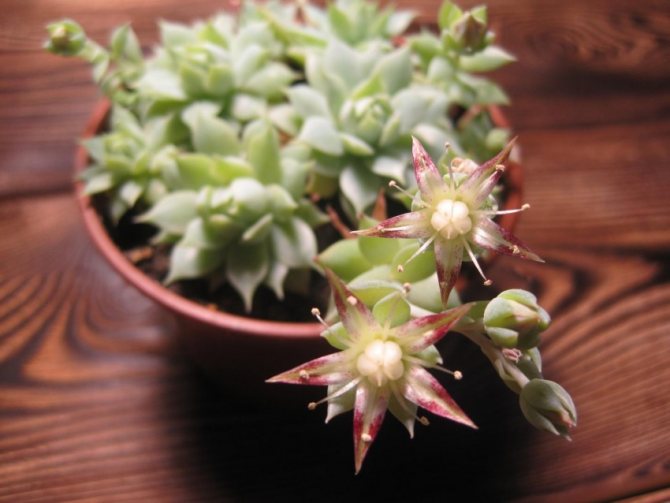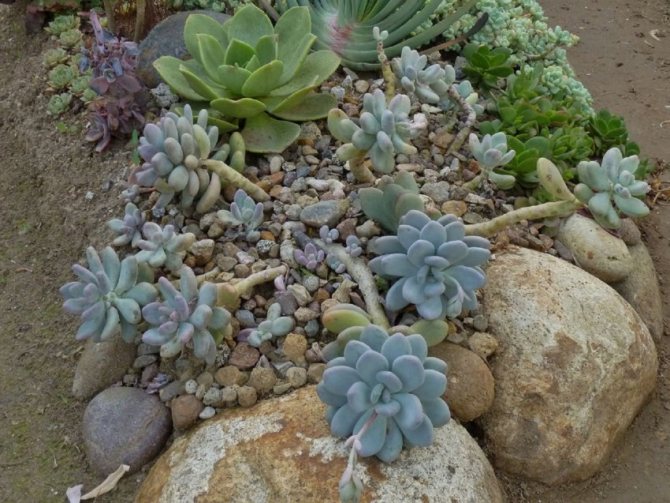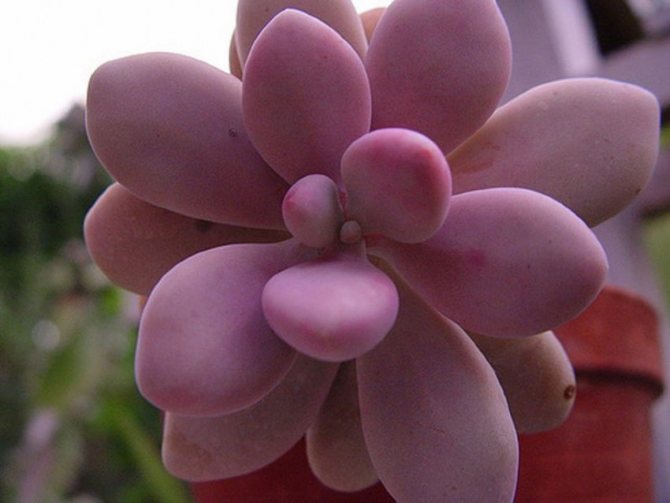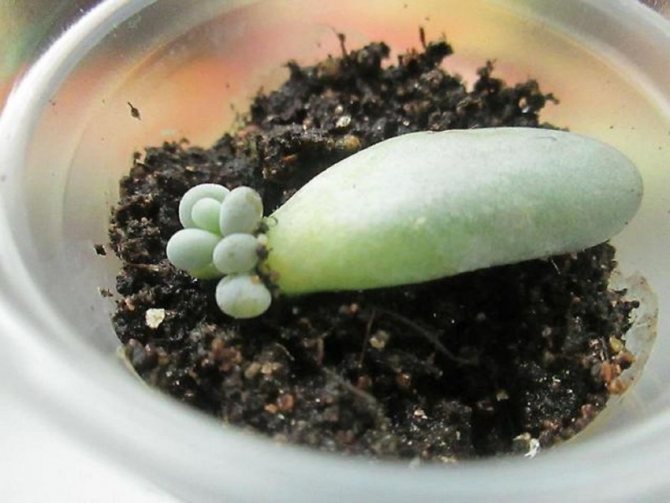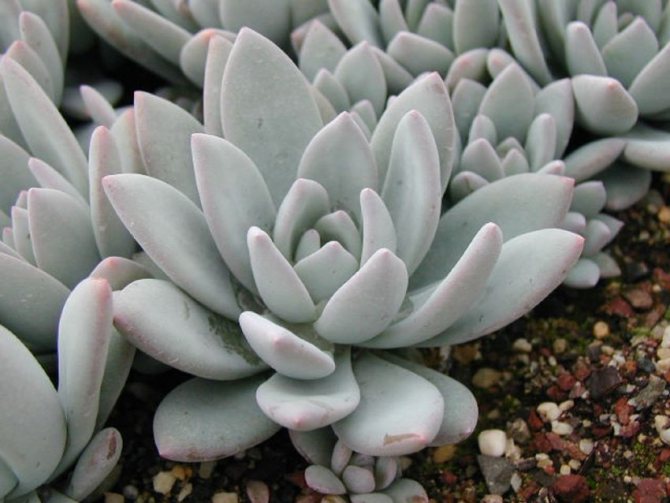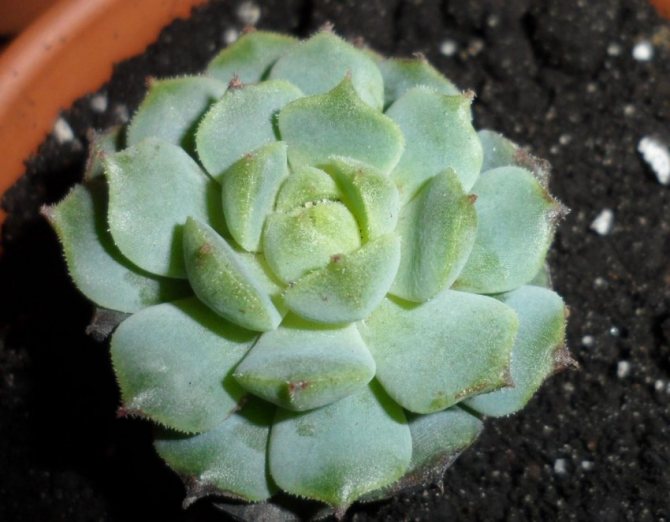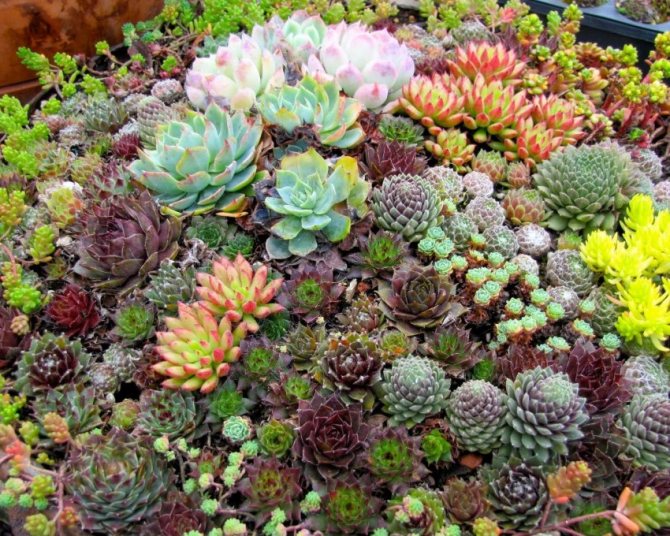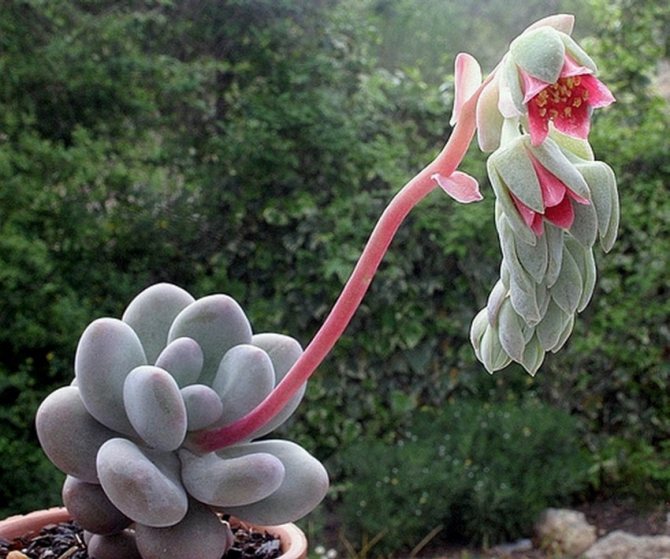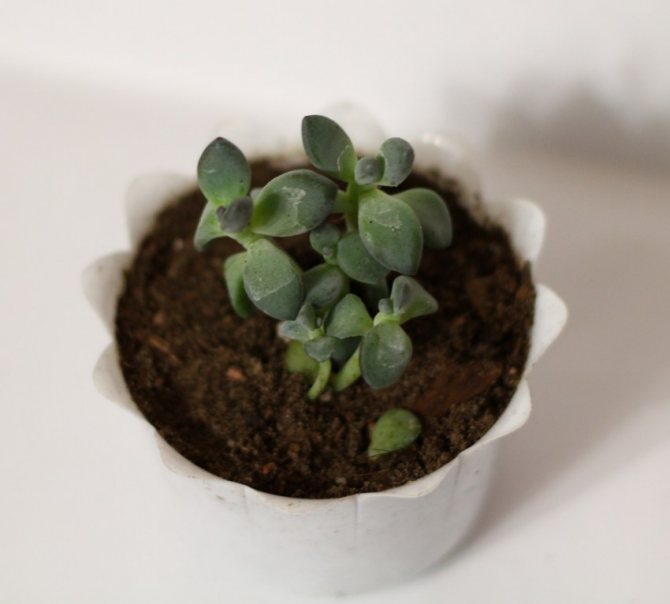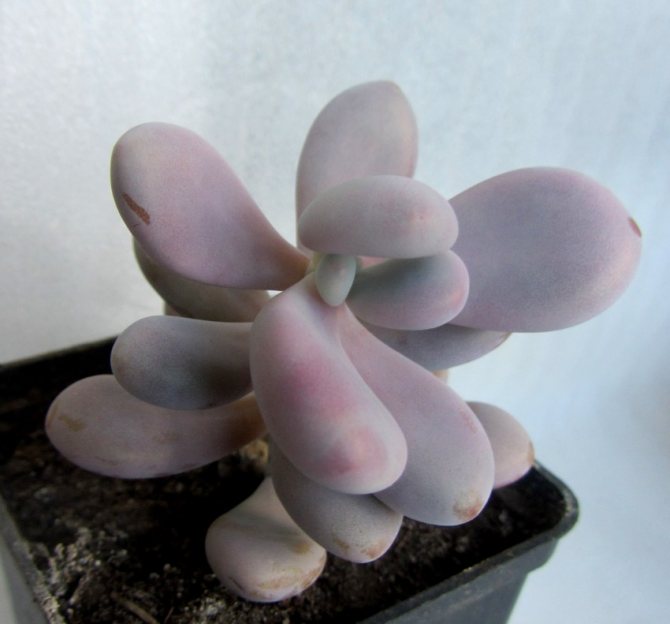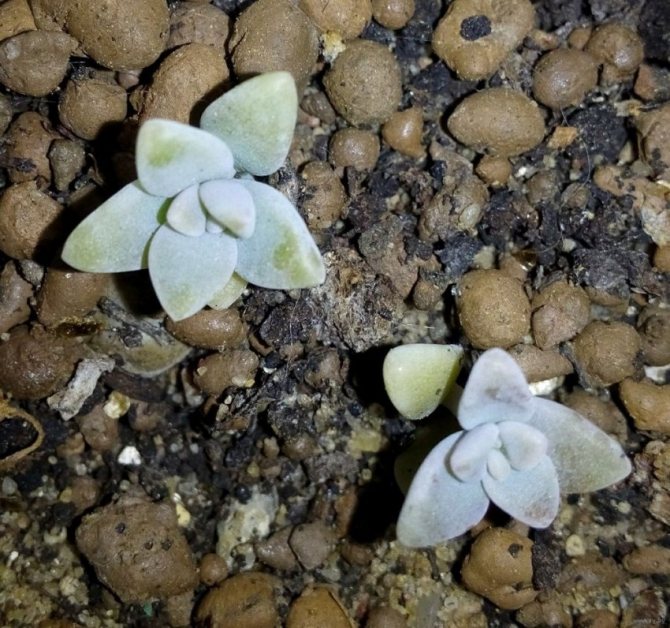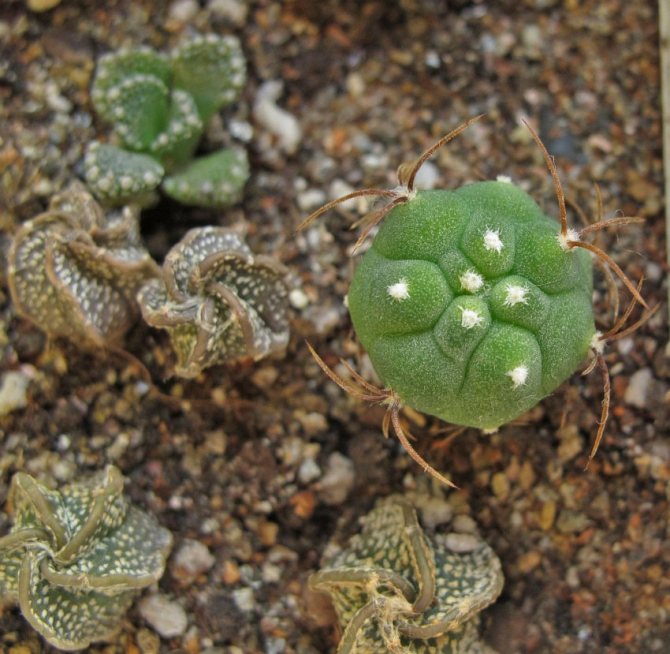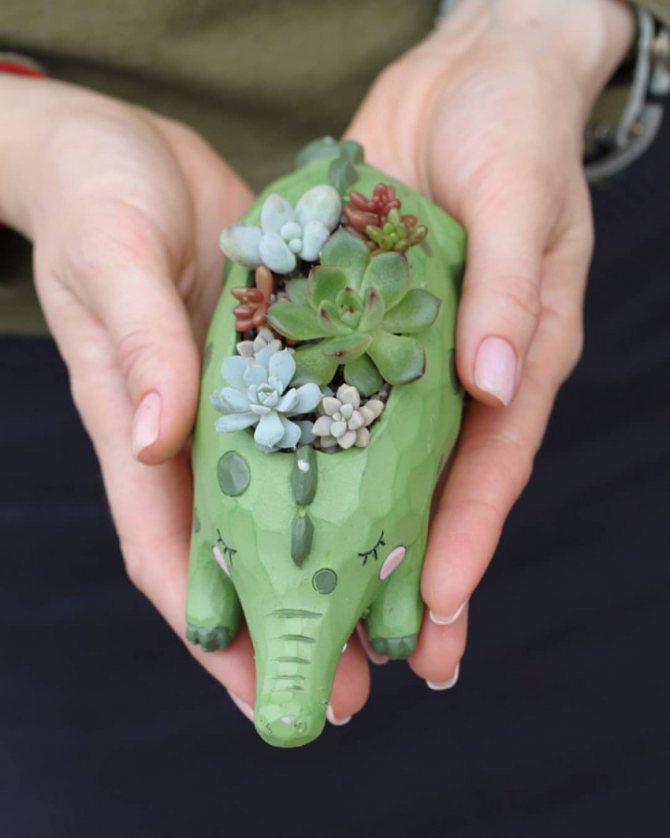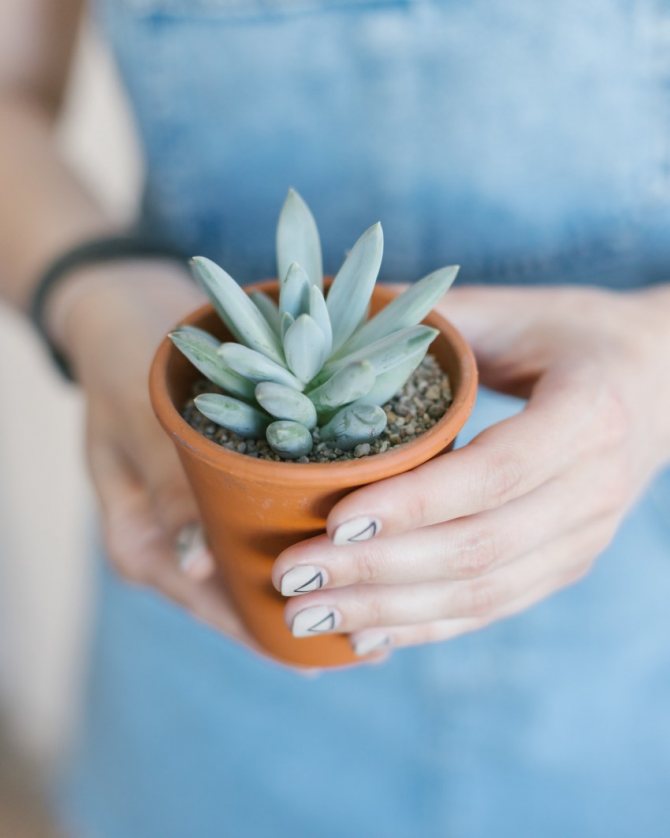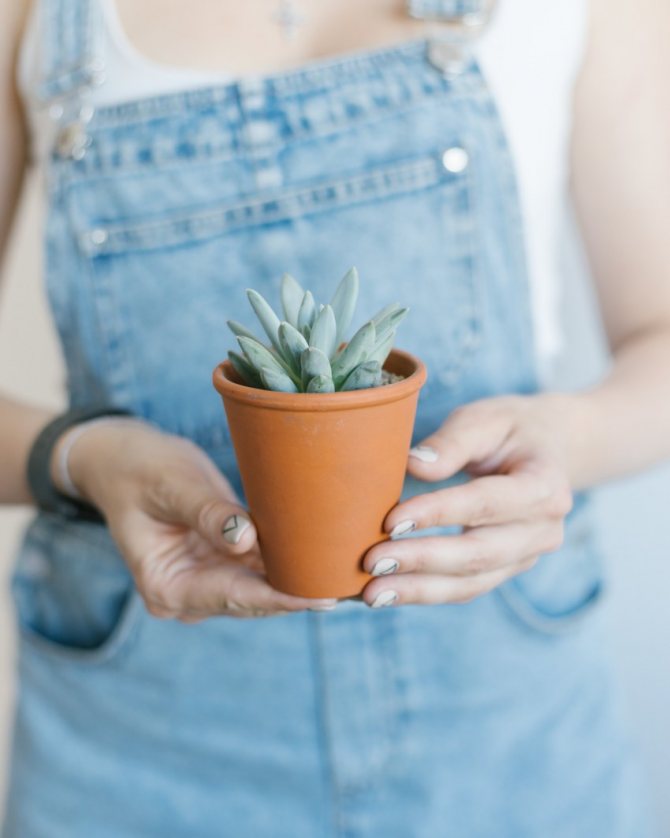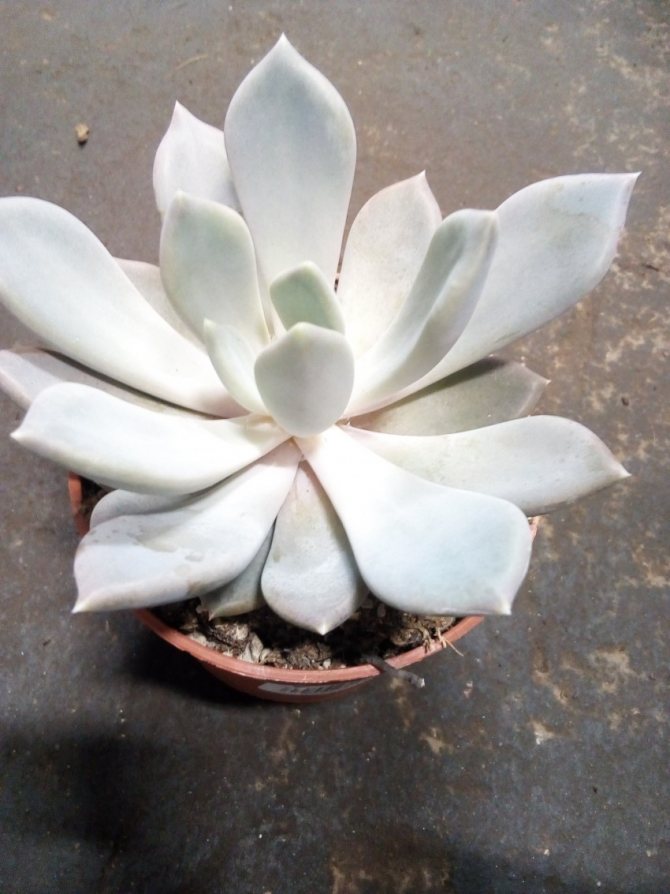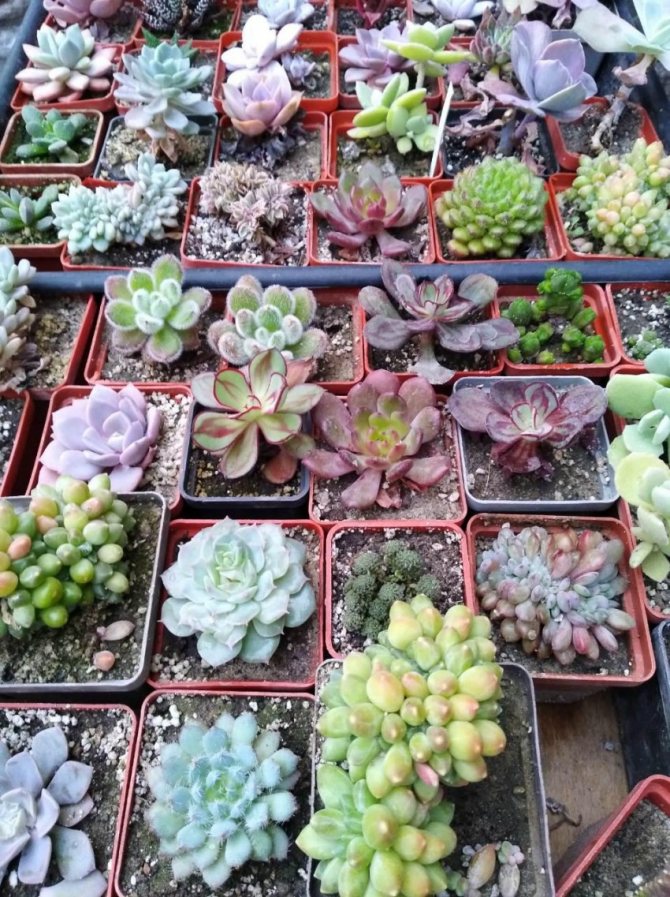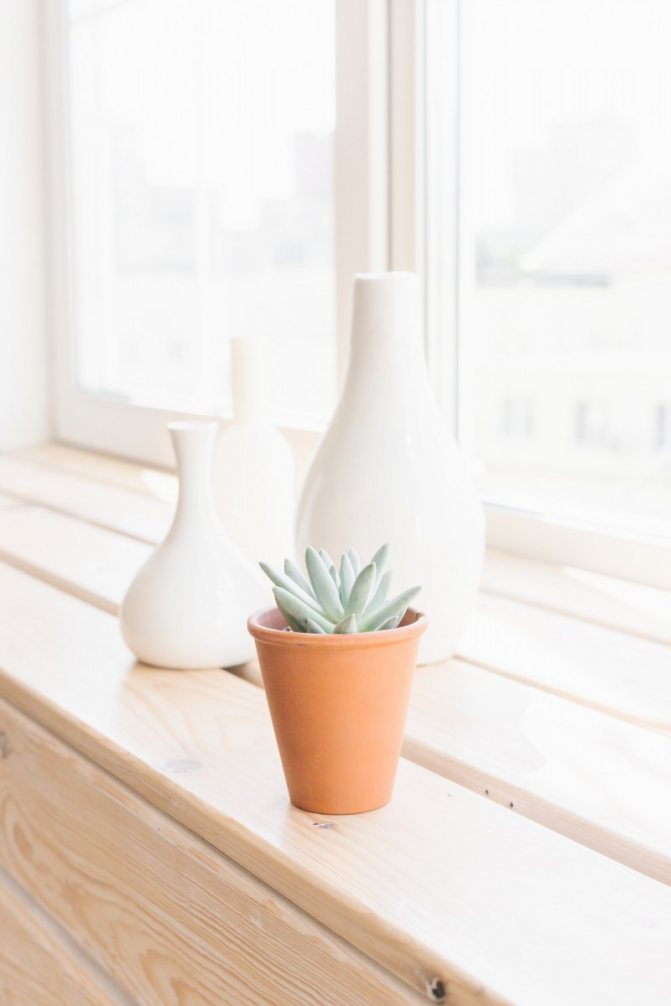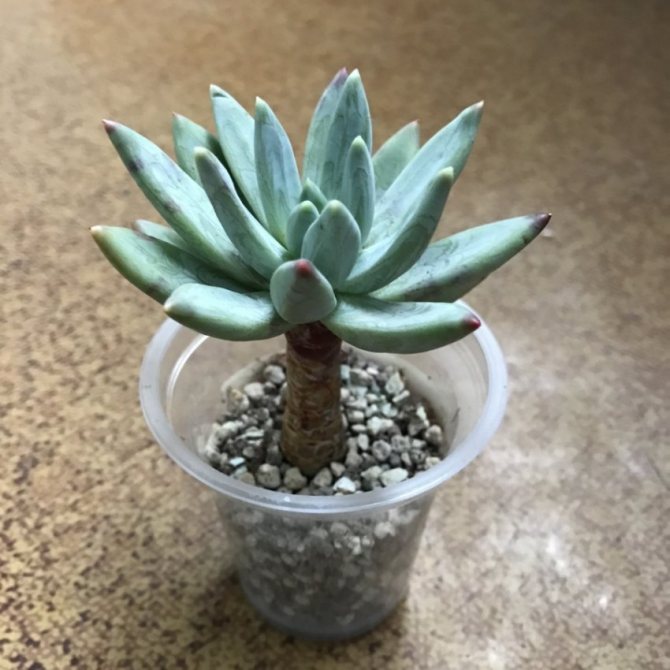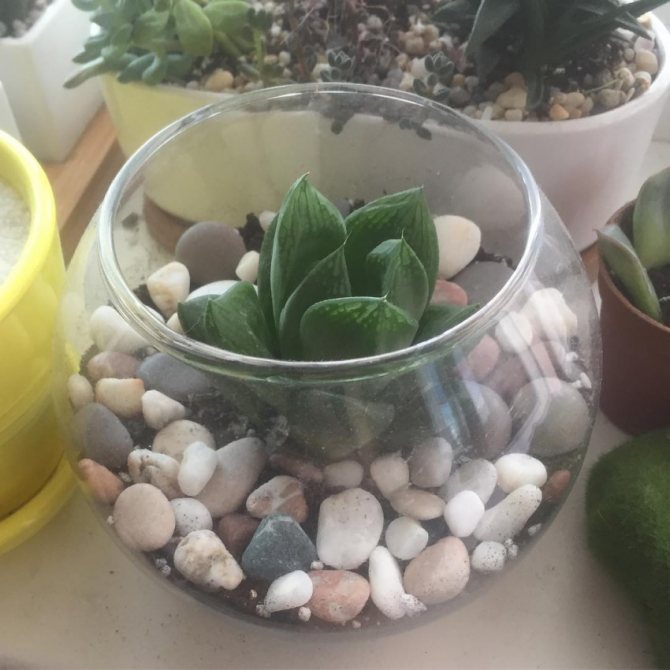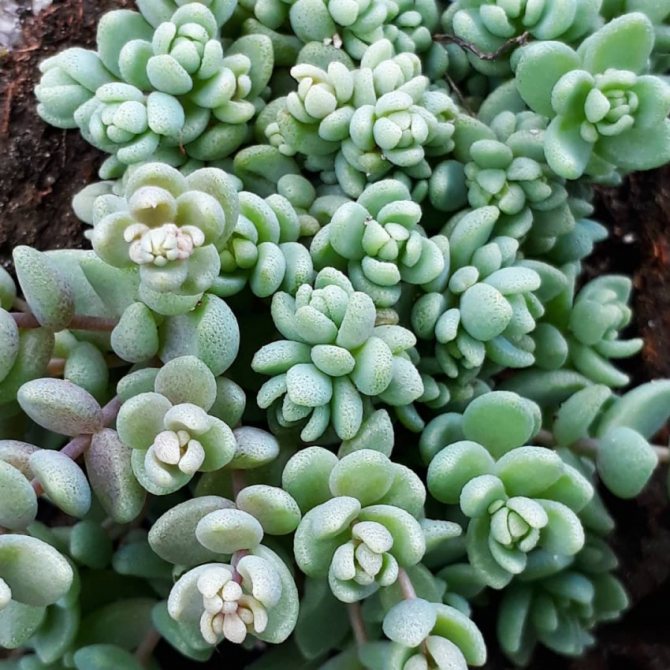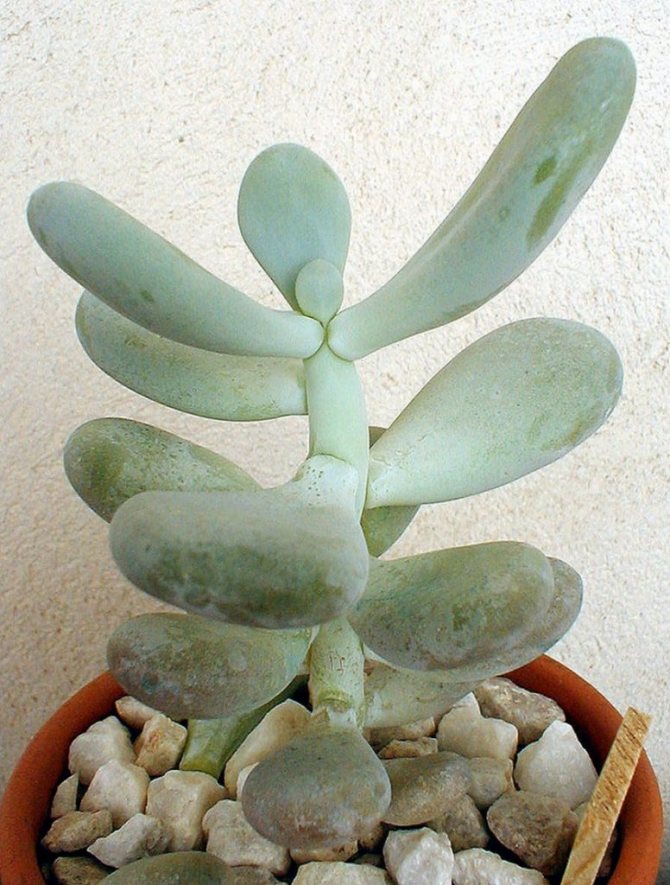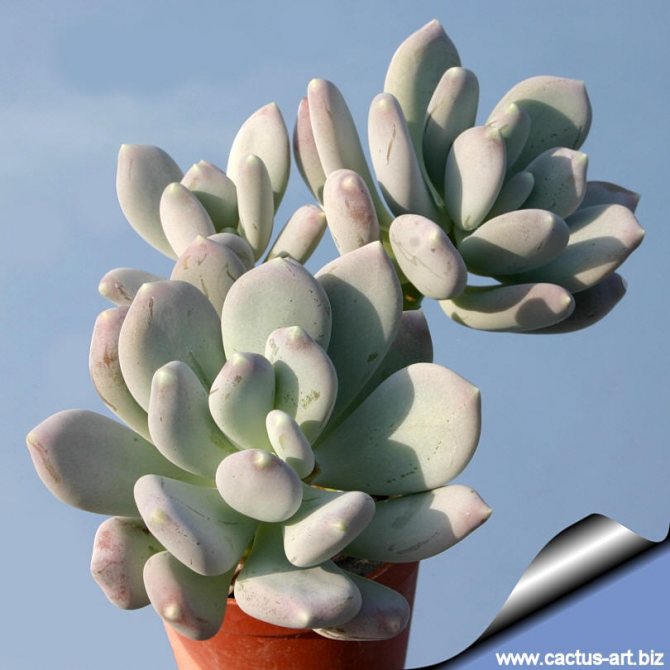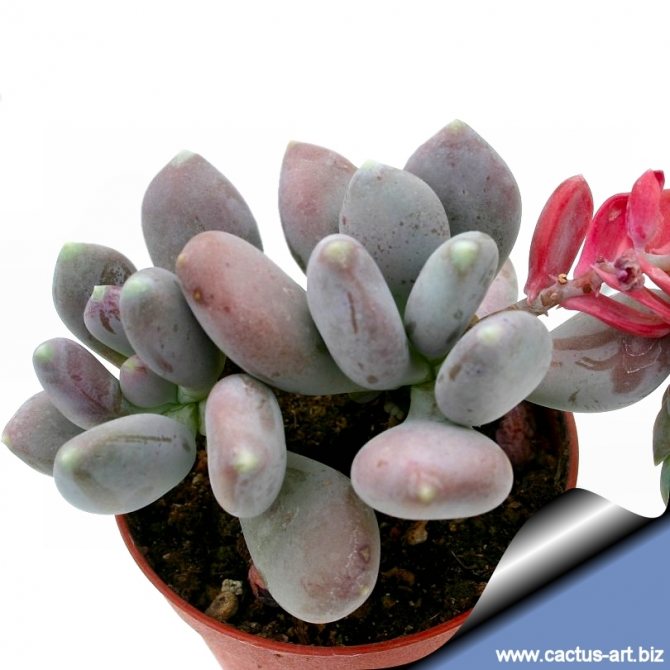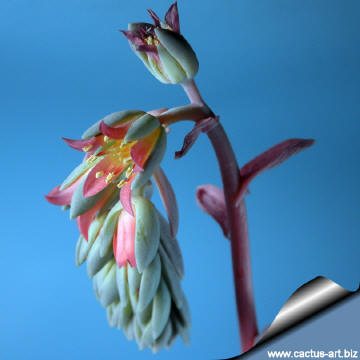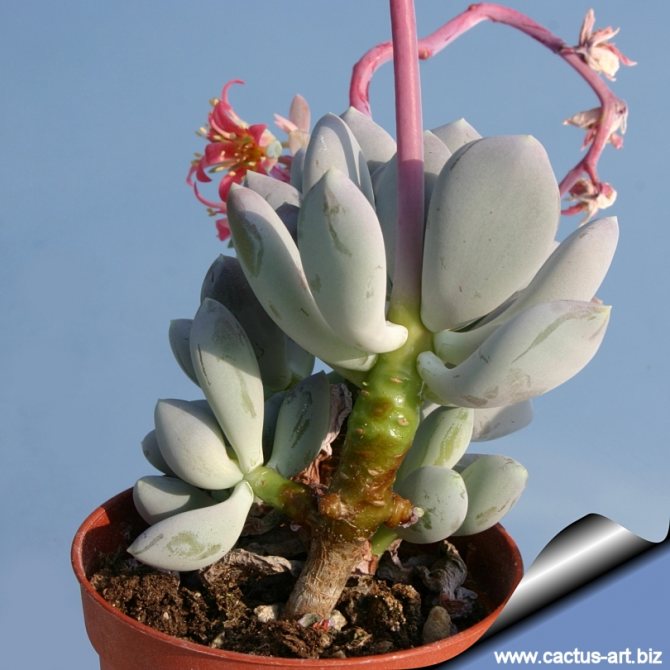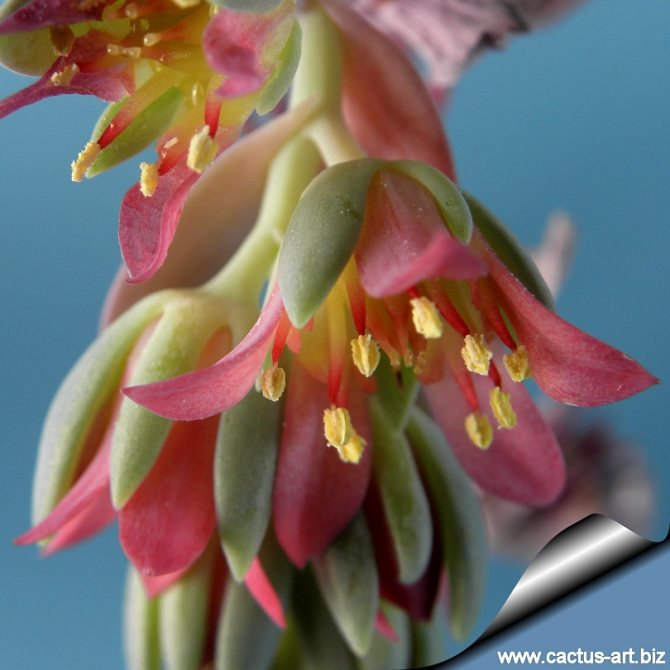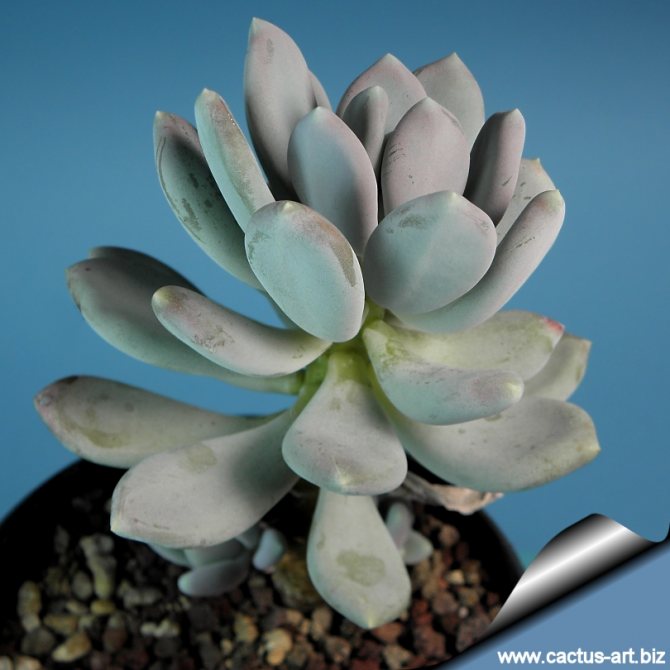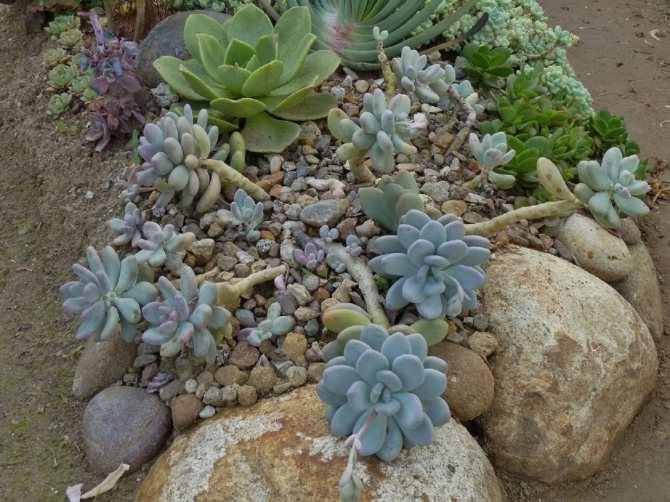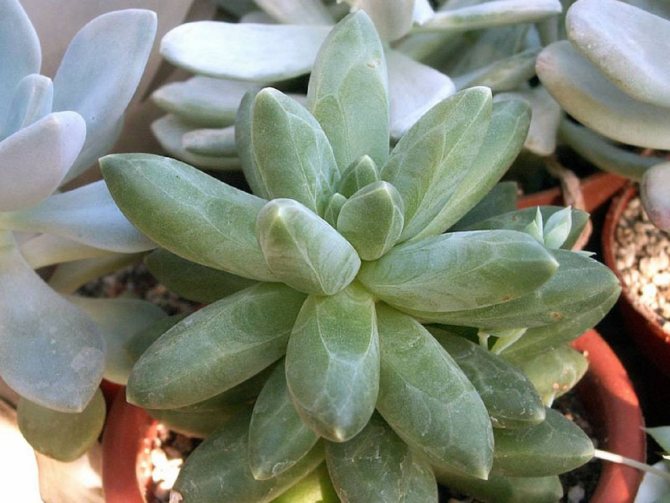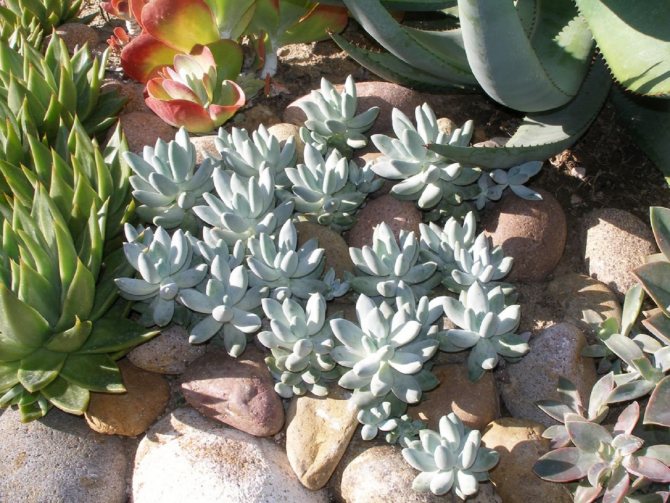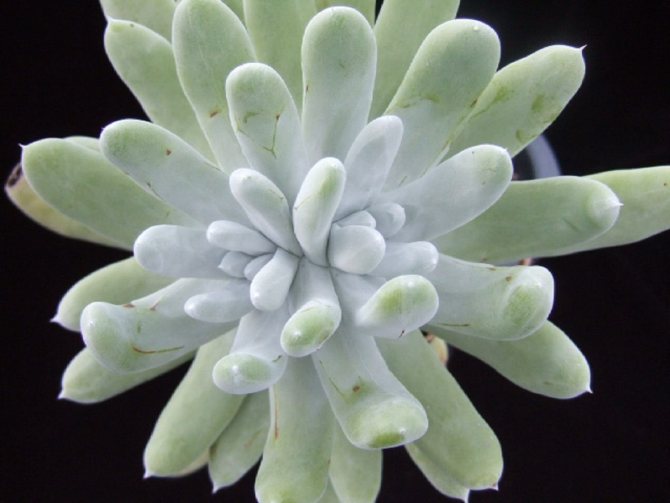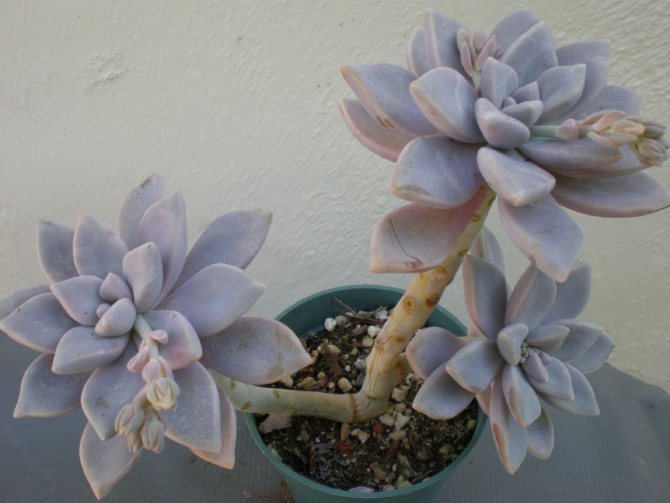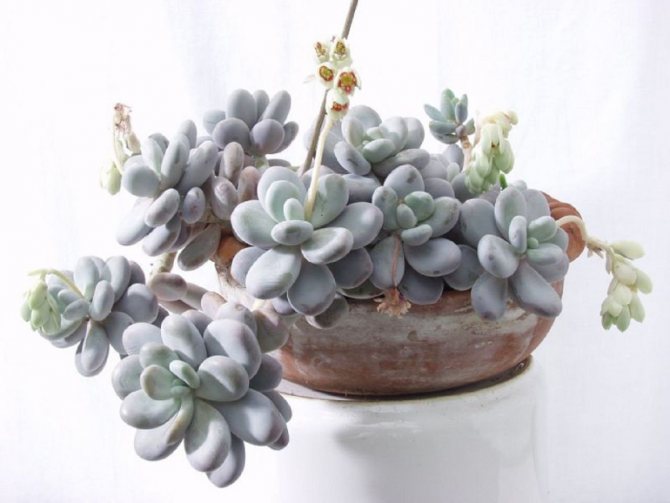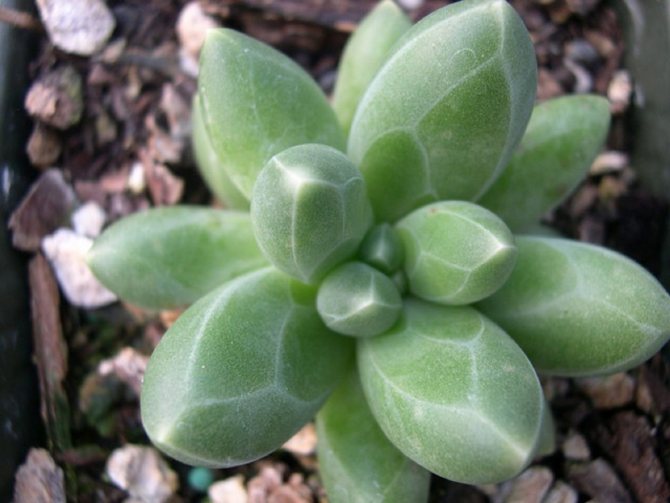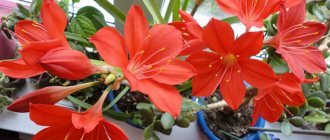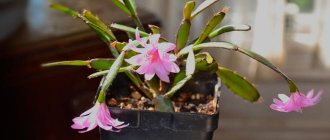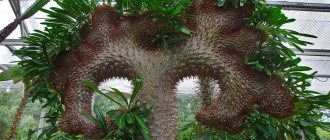Pachyphytum is a compact indoor flower with thick fleshy leaves, most often of a bluish-greenish color, covered with a whitish waxy coating. It was the voluminous leaves that gave the name to the plant: pachyphytum in ancient Greek sounds like a "thick leaf" - the leaves look like a slightly flattened drop. Pachyphytum is native to the arid regions of Mexico.
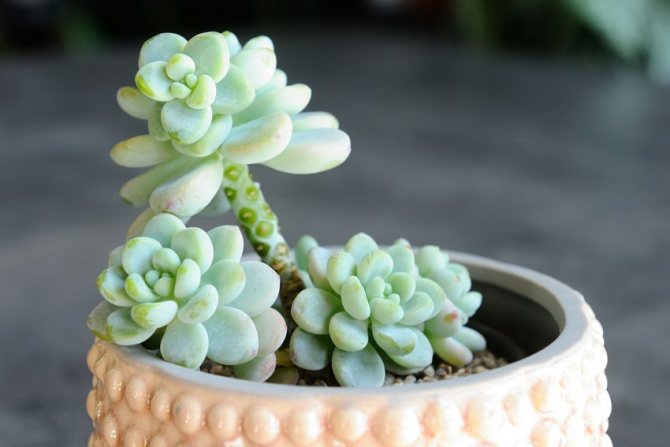
The genus Pachyphytum belongs to the Crassulaceae. Like all succulents, the leaves store moisture and the plant can survive a slight drought.
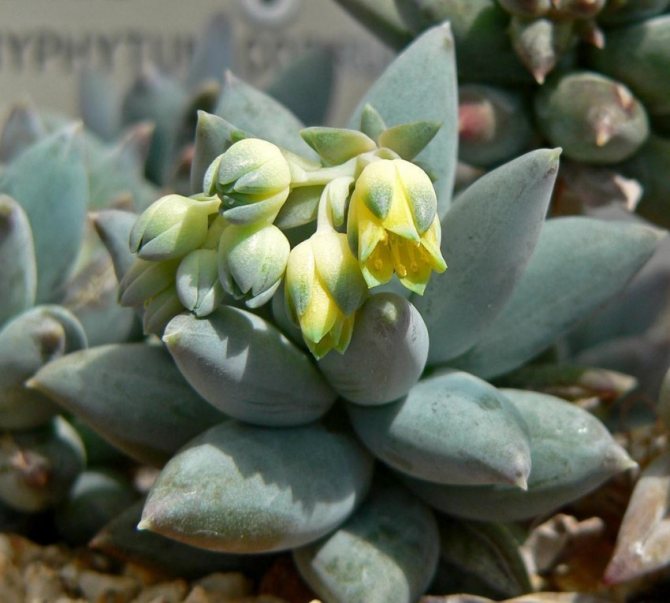

All indoor varieties are small in size. The stem of the flower is drooping or creeping, up to 30 cm long. There are few branches at the stem, it is densely covered with fleshy leaves on short petioles or without them.
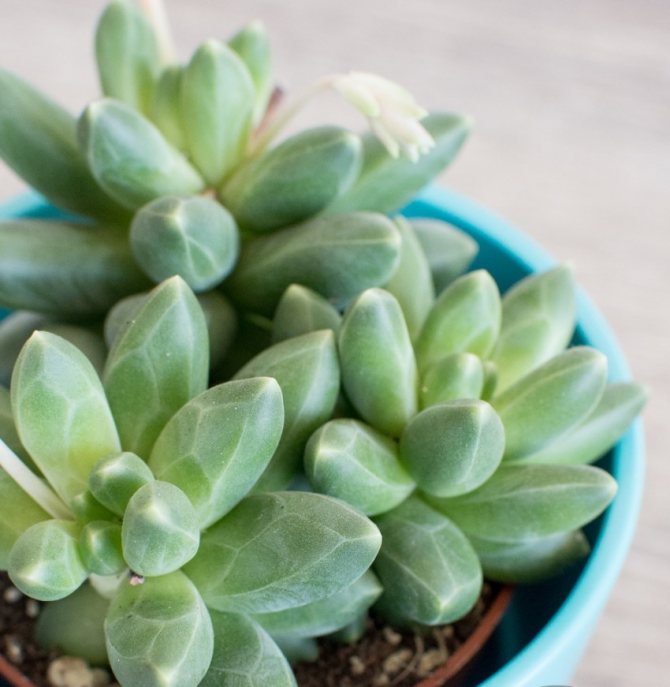

The leaves grow in a spiral, the old ones crumble from the base of the stem, the stem is bare, and a few aerial roots become visible. The leaves are round in shape, with obtuse, occasionally with pointed tips. A branched system of small roots extracts moisture well from the soil.
The flowering time of pachyphytums is from spring to autumn. The inflorescence is a fragrant spikelet with miniature velvety bells in colors ranging from white to red.
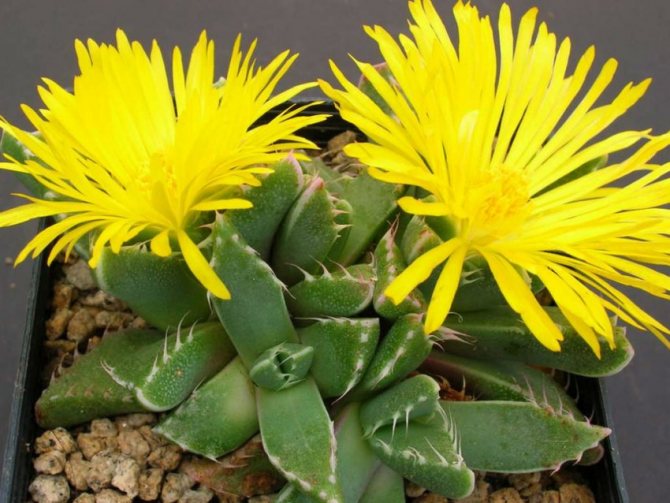

Description
Pachyphytum is a genus of succulent plants belonging to the Tolstyankov family. There are only 17 species in it, but all of them are distinguished by their unusual appearance and high decorativeness.
Plants are small shrubs with thick stems creeping along the ground. On them, almost without petioles, fleshy leaves are densely attached, forming spectacular rosettes of various densities. In some species, they are dense, forming a flower, in others, they are quite rare. The leaves of the plant have a blue-white waxy bloom, characteristic of most succulents. It was for him that Pakhiphytum got its popular name - the Moonstone. This covering of the leaf plates allows Pachyphytum to retain moisture and protects the plant from the sun's rays.
Succulent flowers are small bell-shaped, located on a high, about 15 cm, peduncle. Their outer side is nondescript white and green. The inner one can be yellow, cream, orange and even red.
This representative of succulent in nature often grows among stones or in crevices of rocks, clinging to aerial roots. In indoor collections, it looks original in miniature gardens or is used as a ground cover for decorating large tub plants.
Photo of pachyphytum
Growing
Pachyphytum, which does not have a large root system, is grown in shallow but spacious containers. A succulent plant perceives a transplant well, but needs it as it grows. The need to increase the volume of the container usually arises once every three to four years, since Pachyphytum is a slow-growing plant.
The succulent does not need pruning. Top dressing is usually applied in spring and summer - rarely, about once a month. At the same time, they use a special fertilizer for cacti and succulents.
Care
Home care for pachyphytum is not difficult, the main thing is to know the nuances of this process.
Landing
For sowing pachyphytum, fresh seeds with good germination are used. Planting technology is as follows:
- We disinfect the containers for planting with a solution of potassium permanganate.
- We fill in the boxes with a soil mixture consisting of leafy earth and coarse sand.
- We deepen the grains into the ground by 5 millimeters.You can scatter seeds over the surface and sprinkle with soil.
- Moisten the substrate with a flower sprayer.
- We cover the containers with foil and place the container in a room with room temperature.
- We ventilate the crops every day for 30 minutes, moisten the soil as it dries.
After the emergence of seedlings, the shelter is removed. Grown crops are planted in separate pots.
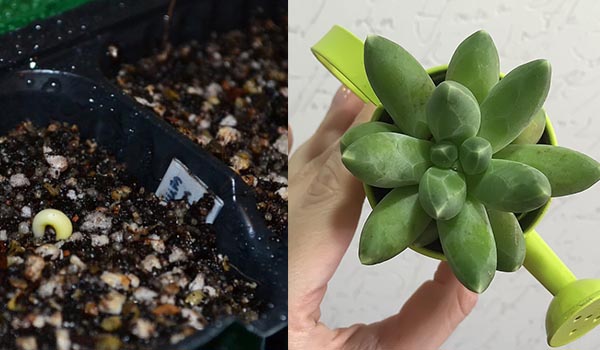

Top dressing
During the period of intensive growth from mid-spring to early autumn, it is necessary to periodically feed the culture. Liquid fertilizers for succulents are applied 3-4 times during the entire growing season. Such dressings should contain a minimum amount of nitrogen.
Watering
Pachyphytum perfectly tolerates drought due to the moisture reserve in the leaves, therefore, when watering the plant, you need to focus on the state of the soil in the flowerpot. Moistening is carried out when the earthen coma dries up to a third of the height.
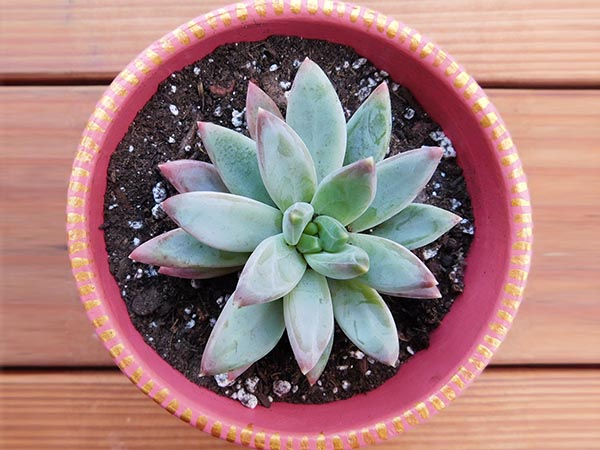

When using a large amount of liquid, the root system of the plant can be damaged, it begins to rot.
Important! Use warm water for irrigation. It is poured along the rim of the pot.
Bloom
Most types of crops begin to bloom in the summer. During this period, the plant throws out a long, slightly curved peduncle with many inflorescences in the form of bells.
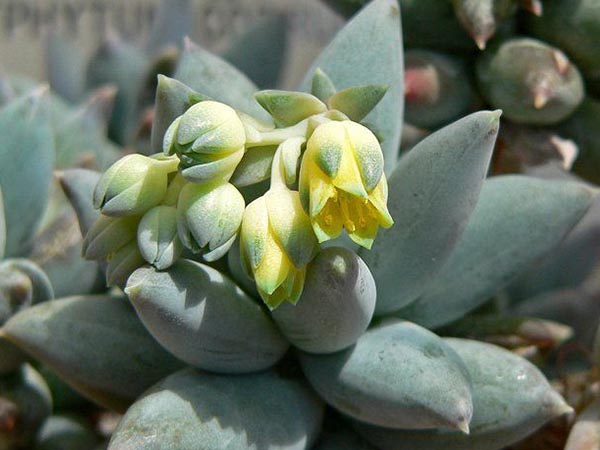

Flowers differ from each other in color and size. To continue flowering, you must use liquid fertilizers with a minimum amount of nitrogen. When the pachyphytum blooms, a slight aroma is felt.
Lighting
This crop is considered a light-loving plant, but when grown on a windowsill at noon, it must be protected from direct sunlight.
It is best to place a flowerpot in the western or eastern part of the apartment. When the culture is placed on the northern windowsill, flowering may be absent, the color of the leaves becomes pale.
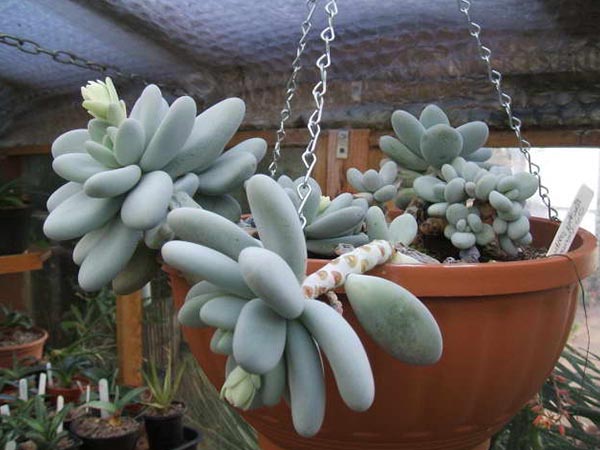

Air humidity
Arid regions are considered the natural habitat of pachyphytum, so the crop does not need additional spraying.
Important! Do not shower the plant through the possibility of damaging the wax coating on the surface of the leaves. This will lead to a decrease in the decorative qualities of the plant.
Air temperature
In the summer, the plant develops well at temperature parameters of 20-26 degrees, it can tolerate prolonged exposure to hot air, but in such cases, periodic ventilation of the room is necessary. In summer, pachyphytum is taken out into the garden or onto the balcony.
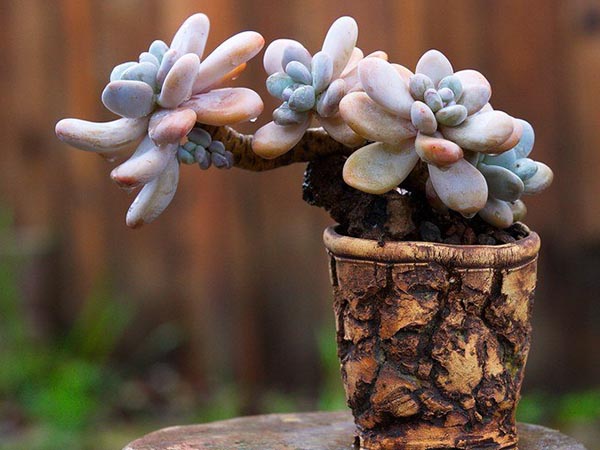

With the arrival of winter, the plant begins a dormant period. It must be rearranged in a cool room with a temperature of 14-16 degrees. When the parameters are reduced to 10 degrees or less, the culture freezes, do not allow this.
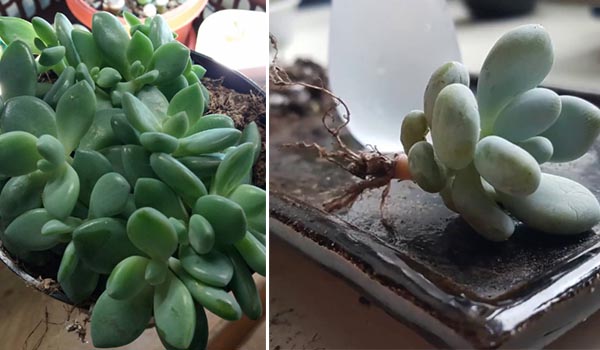

In addition to propagating pachyphytum with seeds, another method can be used. Getting additional plants using cuttings is as follows:
- we cut off part of the shoot from the mother plant with a sharp blade;
- dry and set in a growth stimulant solution;
- we lay the drainage from small pebbles;
- we root the segments in a moist substrate consisting of peat and sand in equal proportions.
The form below describes how succulents reproduce.
During rooting, you need to carefully moisten the soil. When the plant begins to develop, it is transplanted into a new container.
Success secrets
Pachyphytum is a light-loving plant. For its content, it is recommended to choose western and southern windows, while providing diffused lighting. High temperatures are not needed for a succulent, in summer it feels comfortable at moderate, about + 20–22 ° С, indicators, in winter - at lower ones, up to + 8–10 ° С.
Pachyphytum is watered moderately in summer and extremely rarely in winter. It must be remembered that the plant does not tolerate waterlogging. It is not recommended to spray it, as the succulent does not like high humidity.
Watering and humidity
The watering regime for succulents should be moderate - they do not tolerate waterlogging, especially during the dormant period.If the flower is constantly flooded, the roots will begin to rot. It is also not necessary to spray or take a shower - the leaves may begin to rot.
Pachyphytum tolerates short breaks in watering well - after all, in its homeland - Mexico - droughts are not uncommon. Water the plant when the potted earthen feed is about a third of its depth dry. It is also undesirable to completely dry the roots.
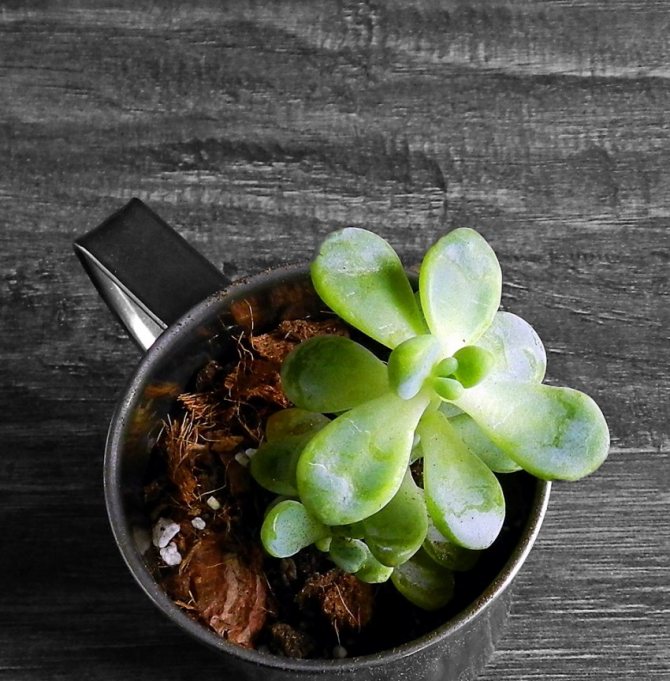

Types of pachyphytum
There are many different types and names of pachyphytums, but only the following are suitable for indoor cultivation:
| View | Description |
| Oviparous | Shrub plant, up to 15 cm high. It has a straight and dense stem. The foliage is blue-white, with a slight purple tint, up to 30 mm long. There is a waxy coating on it. The flowers are pale pink, sometimes with crimson dots. |
| Bracts | Straight stem up to 35 cm high. The foliage is dense and oblong, has scars, a light gray waxy coating is visible. The flowers are deep pink and red. The shape is bell-shaped. |
| Compact (compactum) | A short succulent plant with a thick and fleshy stem. The foliage has a bloom of white marbled color. The flowers are small, pink with yellow tints. The peduncle reaches 40 cm in length. |
| Lilac | Height up to 20 cm. Shrub succulent with a short stem. The foliage is pale green, oblong. The flowers are medium-sized, deep pink. |
| Oviferum | Fleshy stem, up to 20 cm long. Leaves are silvery, waxed, elongated. Small yellow flowers, the center is red. |


Reproduction
For propagation of pachyphytum, cuttings of shoots or leaf cuttings are used. Having separated the cutting from the main plant, it is dried for several days until the cut site is tightened.
Then the stalk is slightly instilled into the ground, providing it with some kind of support. You can water it in a few days.
Pachyphytum takes root with difficulty, but if you do not overflow the soil and create high moisture content for the plant, then after a while the cutting will take root. For more successful rooting, phytoharmonic feeding is possible.
Pachyphytum is resistant to fungal diseases that affect other indoor plants, but it can be damaged by an insect such as a mealybug.
The adults and larvae of this pest are sucking insects. They suck the juices from the leaves, buds and stems of the succulent. When it appears on a plant, it becomes covered with a white cobweb.
The leaves begin to dry out, the buds fall off. In addition, the sticky secretions of these pests are a favorable environment for the development of black fungi.
If signs of the appearance of a worm are found, it is necessary to moisten a cotton swab in soapy water and wipe the leaves of the damaged plant, removing the larvae and adult insects. Then it is necessary to spray the pachyphytum.
This must be done 3 times with an interval of one week. You can use infusion of garlic, tobacco infusion, infusions of other strong-smelling plants. It is good to treat the plant with alcohol or calendula tincture, which is purchased at the pharmacy.
In case of severe damage to the succulent by pests, it is necessary to use drugs - insecticides. These include "Admiral", "Aktellik", "Fitoverm", "Vertimek", etc. Do not forget that insecticidal drugs are very toxic. Their use is not possible indoors.
Pachyphytum is very popular among succulent breeders and simply flower growers.
Any novice cactusist can easily grow this plant at home - it is undemanding to care.
Experienced florists create mini-gardens from succulents in indoor conditions. Due to its unusual appearance, pachyphytum occupies a worthy place in them.
This evergreen plant - long-liver attracts everyone's attention. Buy pachyphytum and grow your "moonstone" on the windowsill.
If you find an error, please select a piece of text and press Ctrl + Enter.
The genus of plants Pachyphytum belongs to the Crassulaceae family. It contains about 10 species of succulent plants, which are endemic to various regions of Mexico.A common feature of such plants are juicy, rather thick leaves, which are similar in size and shape to a flattened elongated grape, painted in a light greenish-gray tint and having a whitish waxy coating on the surface. Thanks to its foliage, this genus was named pachyphytum, which in Greek means “thick-leaved”.
Such plants are quite compact. So, creeping or lodging shoots are practically never longer than 30 centimeters. They are distinguished by short internodes. The leaves grow in a spiral, while they are located very tightly, you may even get the impression that they are collected in whorls. Smooth and rather long peduncles appear from the apical sinuses during the flowering period. They bear spike-shaped, low-flowered inflorescences, which consist of small 5-petal drooping bell-shaped flowers. They can be colored pink, white or red. The sepals, like the leaves, are puffy, and there is a waxy coating on their surface. The seeds ripen in small pods.
Methods for obtaining indoor pachyphytum, planting, transplanting
The succulent plant should be grown in small pots with large drainage holes. During the initial planting, fill the bottom of the container with a drainage layer consisting of pebbles and expanded clay. The soil should be neutral or slightly acidic. You can opt for the soil for cacti and succulents, or prepare the substrate yourself, for this, sod and leafy soil, as well as river sand, should be mixed in equal proportions.
The transplant should be carried out in the spring every 1-2 years.
You can get a new houseplant by cuttings and planting a seed, but the second method is practically not used anymore.
Reproduction of pachyphytum
Most indoor plant species do not set seeds. Young lateral shoots and leaf cuttings are chosen as planting material for the propagation of pachyphytum.
The plant takes root rather difficult. The processes cut off for planting are first dried for at least a week, until the cut wounds are healed, and the liquid stops oozing from them. So it is more likely that the stalk will not rot.
The dried shoot or leaf stalk is buried in the succulent substrate to a minimum depth, providing it with a stable support to keep it upright. Watered lightly, without overmoistening or overdrying, do not cover with anything.
Rooting is slow, up to several months, so it is rational to add a little phytohormone to the water for irrigation for better root formation - root or POKON.
Pachyphytum care at home
Pachyphytum care at home depends on the season of the year:
| Parameter | Spring Summer | Autumn winter |
| Location, lighting | Photophilous, needs bright lighting, therefore it is located on the southern windows. | |
| Temperature | + 20 ... + 26 ° С. Often ventilated, can be taken out into the open air. | + 10 ... + 16 ° С. Is at rest. |
| Humidity | It tolerates dry air well and does not need additional humidification. | |
| Watering | 2 times in 7 days. | Once a month. If the temperature is less than +10 ° C, it is recommended to refuse watering. |
| Top dressing | Fertilizers with a low nitrogen content are applied 3-4 times. | Not carried out. |
Temperature regime
The optimal daytime regime in summer is 20-26 ° С, a significant difference between day and night is desirable - such a difference exists in the natural habitats of succulents.
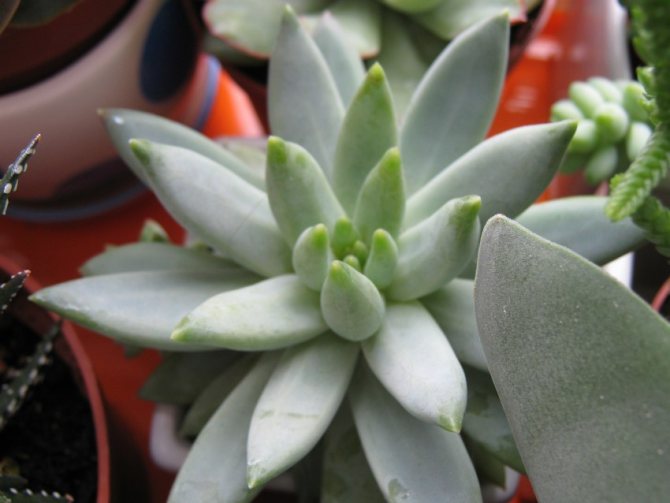

In winter, during the dormant period (from October to April), it is desirable to maintain the temperature in the range of 12-16 ° C, it is possible to lower it (about 10 ° C). It is highly undesirable to place a flower on a windowsill directly above the battery.
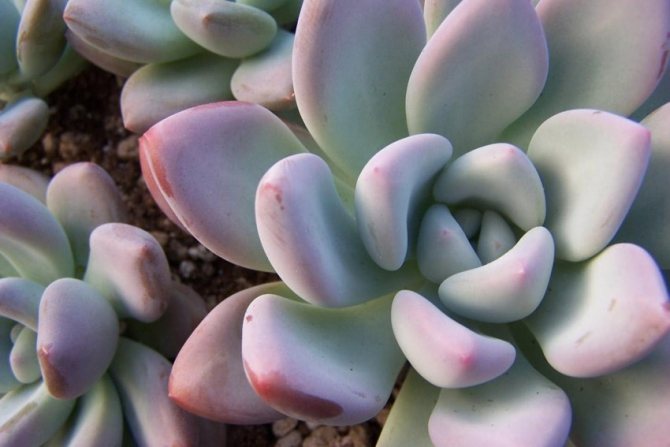

Types of pachyphytum
Pachyphytum egg-bearing - a succulent plant with a creeping stem about 1 cm thick and 20 cm long, the base of which is covered with traces of fallen leaves. Bluish-gray leaves are round, juicy, about 5 cm in diameter. In bright light, the tips of the leaves turn pink.From July to September, it produces straight peduncles up to 20 cm long with a cap of pinkish-white bell-shaped flowers.
Blooming Pachyphytum Egg-bearing
Pachyphytum Bracts - perennial succulent with creeping stems about 30 cm long and 2 cm thick. Squeezed elongated leaves, covered with a silvery waxy bloom, are collected in compact rosettes at the tops of the stems. The largest leaf size is 10 cm long, 5 cm wide. Red flowers on a peduncle up to 40 cm long appear in August-November.
Pachyphytum Compact
Pachyphytum Compact - stem no more than 10 cm, completely leafy. The leaves look like a flattened grape about 4 cm long, dark green in color with a whitish marble pattern. In the middle of spring, a peduncle about 40 cm long appears with bell-shaped flowers of red-orange color.
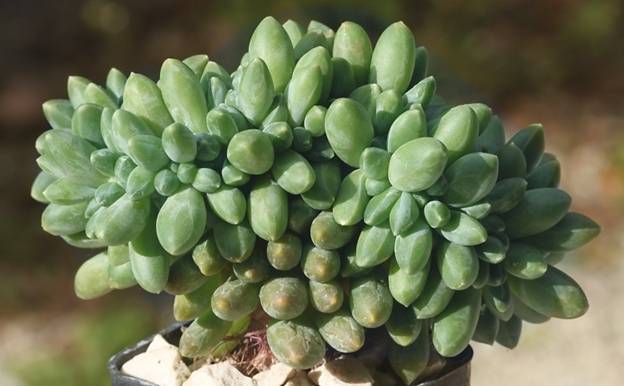

Pachyphytum Compact
Pachyphytum Lilac - the short stem is covered with elongated leaves up to 7 cm long. Leaves and shoots are covered with a lilac wax bloom. The flowers are pink bells.
"Moonstone" on your windowsills - pachyphytum
The homeland of pachyphytum is Mexico, its regions with an arid climate. It is also found in the southern part of America. We owe the appearance of the succulent in Russia to Peter the First.
Pachyphytum is an unusual plant. It can consist of a rosette of leaves, or it can look like a bunch of grapes.
A feature of the succulent is its leaves. For their color and unusual shape, some types of pachyphytum are called "moonstone" or "candied almonds". They are thick, fleshy, covered with a white coating, similar to powdered sugar.
The leaves are very close to each other. Depending on the type, they can be obovate or with a pointed end. The color of the leaves is blue-white or gray-green. Due to the white coating, their color can resemble silver.
Thick stems are lodging or creeping up to 30 cm long. Leaves are located mainly at the ends of the stems. With increasing age of the plant, the leaves may fall off, and small indentations remain on the stems.
During flowering, a long peduncle appears on the plant, on which white, pink, red, light green bell-shaped flowers bloom.
The sepals of flowers, like the leaves, are thick, juicy, with a white bloom.
Pachyphytum blooms from mid-summer to mid-autumn. During the winter, the plant continues to be dormant. At home, pachyphytum does not set seeds.
Currently, more than 10 species of pachyphytum are known. But not all of them are suitable for home growing.
The following types are suitable for this:
- Oviparous.
- Bracts (bracteosum).
- Compact (dense).
Oviparous
Most often, florists grow this type of pachyphytum indoors.
The oviparous pachyphytum has a thick stem 20-30 cm long. On the stem are spatulate or obovate oval leaves, the width of which is about three, and the length is about 5 cm.The thickness of the leaves is about 1 cm.
The stem of the ovoid pachephytum is straight at a young age. Over time, it grows up to 30 cm long and spreads over the surface. Leaves cover only the upper part.
Flowering begins in July. A long peduncle grows from the center of the stem, on which greenish-white bells interspersed with pink gradually appear.
A peduncle with flowers on it resembles a spikelet that begins to bloom from below until all the flowers open. Flowering continues until September.
Bracts
In bracts pachyphytum, the length of a thick stem reaches a size of up to 30 cm. Silvery, with a pinkish tinge, the leaves are elongated and slightly flattened.
The width of the leaves is 5 cm and the length is about 10. As the plant ages, the leaves begin to fall off and cover only the upper part of the stem.
From August to November, red bells bloom on a peduncle that has grown to 40 cm.
Compact
The stem of the compact pachyphytum does not exceed 10 cm. Thick leaves about 4 cm long have a pointed tip. Their colors are unusual - silvery stains are barely visible on a dark green background. It looks like marble. The leaves are located along the entire length of the stem and form a rosette. In adult leaves, the edges sometimes turn red.
In summer, orange-red flowers with blue edges bloom on an approximately 40-centimeter curved peduncle. They are surrounded by light blue sepals.
Caring for pachyphytum at home is not difficult at all. Even a novice florist can handle this.
The plant is very hardy.
It can be in the hot sun, in a cold room, do without watering for a long time, spraying for pachyphytum is unacceptable, because it prefers a low percentage of air humidity.
Planting, as well as transplanting pachyphytum, should be carried out in the spring, when the plant is still in a state of relative dormancy. The size of the pot must be determined based on the size of the plant.
Succulent grows slowly, several centimeters per year. But it grows very much with age. Therefore, it is advisable to transplant pachyphytum every spring into a more spacious container.
Drainage must be poured into the bottom of the pot. The soil should consist of a mixture of leafy, turfy soil and coarse sand.
Sand can be replaced with brick chips. It is better not to introduce peat, because it will add looseness to the soil, and in order for the plant to grow more steadily, it is necessary that the soil is relatively dense.
The soil should be neutral in terms of acidity or slightly acidic and poorly nutritious.
Planting pachyphytum should be carried out as carefully as possible, without touching the leaves with your hands.
If you wipe off the dusting on them, the sheet may die.
Feeding the succulent should be carried out during the period of the active life of the plant - from spring to autumn.
To do this, several times during this time, you need to add a solution of potassium-containing fertilizers under the root. The amount of nitrogen in them should be minimal.
Pachyphytum is a succulent plant, which means that a certain supply of water accumulates in its leaf tissues.
It is accustomed to an arid climate, so it should be watered a little and infrequently: when the soil in the pot is dry. In the spring and summer period, it will be enough to spray the soil with water every two weeks. In very hot summers, you can do this weekly.
In winter, it is enough to water the plant once a month. But if the temperature in the room does not reach 10 degrees, then it is better to refuse watering. This is fraught with the death of the plant.
Watering must also be done with special care, without getting on the leaves and stem of the pachyphytum. Excessive moisture will begin to rot the plant. In no case should you water it abundantly.
Pachyphytum begins to bloom in summer. A short or long, straight or curved peduncle, smooth in structure, grows from the center of the stem. On it, surrounded by sepals of a silvery or light green color, bell-shaped flowers subsequently appear - small or larger in size and different in color.
Succulent blooms until the end of autumn, until the dormant period begins. The smell of pachyphytum flowers is practically not felt.
Lighting for pachyphytum should be bright. It easily tolerates direct sunlight. Shading of the plant is allowed in some cases.
With insufficient light, the leaves of the plant begin to lose their color, become dull, flowering may not occur.
Air humidity for pachyphytum should be low enough.
In a humid environment, the casting, stem and root of the plant begin to rot.
The plant dies.But in a very dry room at a high temperature, the plant needs fresh air to form flowers.
In the spring-summer period, the pachyphytum pot must be taken out to the balcony, loggia or to the backyard. If this is not possible, it is necessary to ventilate the room where the succulent is kept.
The most comfortable temperature for pachyphytum is 20-25 degrees. A succulent, accustomed to desert heat, will easily endure a hotter summer.
In winter, during the dormant period of the plant, it is necessary to provide it with a cooler microclimate.
A temperature of about 15 degrees will be the most suitable for him. At below 10 degrees, pachyphytum can freeze. The leaves will fall off, there is a high probability that the plant will die.
> Photo
"Moonstone" - pachyphytum:
Pachyphytum care
Pachyphytum is an easy-to-care plant, depending on the species, reaching 15-50 cm in length.
Temperature and lighting - the plant is resistant to both heat and low temperatures. In summer, it easily tolerates a heat of 35 degrees, in winter you need a cool content, but not lower than 5. Pachyphytum is not afraid of drafts, even cold ones... He needs the brightest light, put it in the most illuminated place in the apartment. It can survive in partial shade, but it will stretch out and lose its decorative effect.
Air humidity and watering - pachyphytum is a drought-resistant plant. At the beginning and end of the growing season, it is watered once a month, in winter it is not moistened at all... From late spring to early autumn, it should be watered abundantly, but rarely, allowing the soil to dry thoroughly... The water from the pallet must be drained.
Fertilization and feeding - from late spring to early autumn, once a month with diluted fertilizers for cacti.
Soil and transplant - the root system of the pachyphytum develops more slowly than the aboveground part and it is better not to disturb it once again. It is transplanted no more than a year later in the spring into a ready-made substrate for cacti with the addition of sand or brick chips... There must be holes in the pot and good drainage.
Bloom in spring, a long peduncle with bell-shaped flowers protrudes from the center of the rosette.
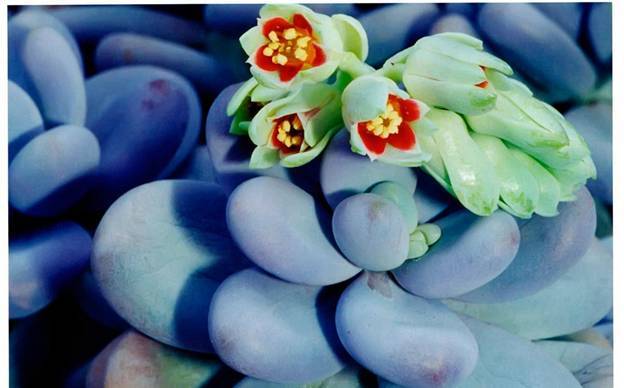

Blooming pachyphytum
Diseases and pests
The pachyphytum flower is resistant to diseases, not damaged by pests. Only excessive watering and high air humidity can be a problem - the flower is susceptible to leaf and root rot.
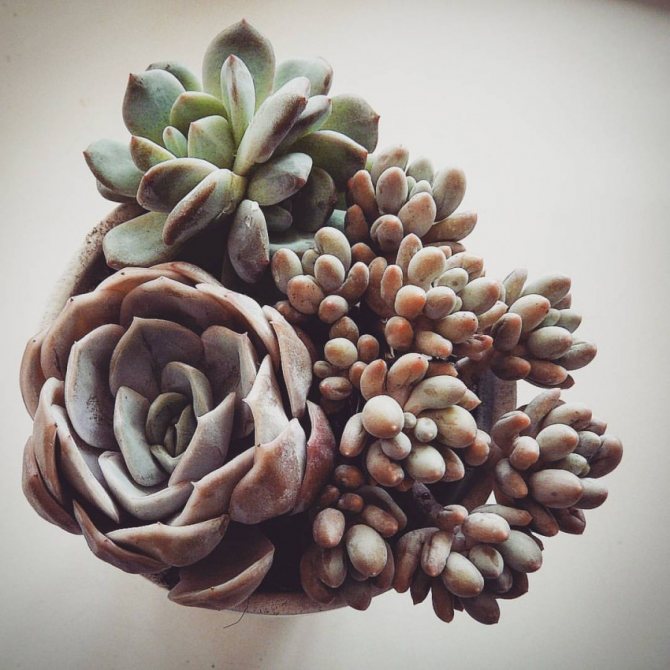

If rot has already arisen, then it is easier to root cuttings from healthy parts of the plant than to save the damaged one. When transplanting, it is imperative to disinfect the pots.
Growing pachyphytum from seeds
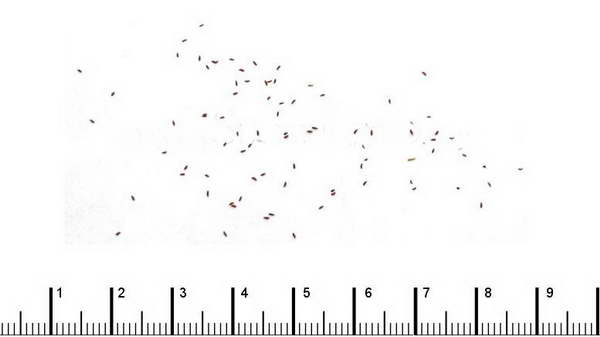

Pachyphytum seeds photo
For sowing, it is advisable to use fresh seeds with good germination.
- Sowing in boxes with a mixture of sand and foliage of the earth.
- Moisten the soil, deepen the seeds by 0.5 cm. You can sprinkle it on the surface less often and sprinkle it with earth on top.
- Moisten the soil with seeds with a spray gun.
- Cover crops with foil, maintain air temperature within 20-24 ° C.
- Air daily for 30 minutes, periodically moisten the soil.
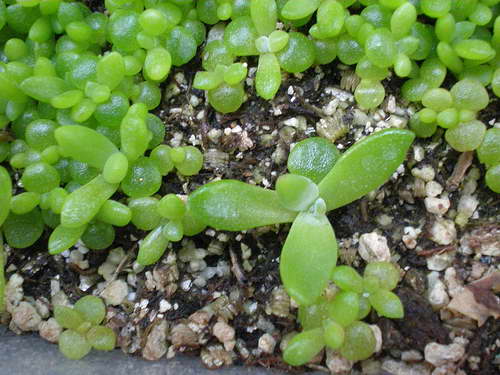

Pachyphytum from seeds photo of seedlings aged 3 months
- Remove the cover when shoots appear.
- When young plants grow up, they should be planted in separate containers.
Propagation of pachyphytum by cuttings
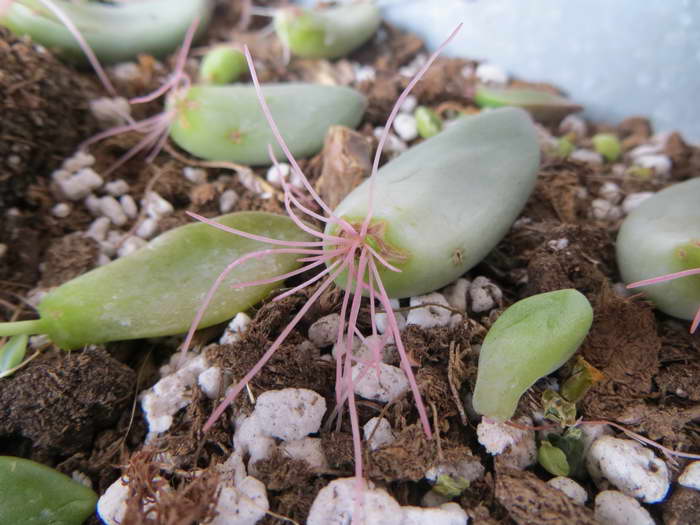

Leafy cuttings of pachyphytum with roots photo
You can root stem and leaf cuttings.
- Carefully cut the stalk with a blade, dry it a little, treat it with a growth stimulator.
- Root in a sandy peat mixture.
- You can put pebbles or create other support so that the cutting does not come into contact with the soil at the cut.
- Moisten the soil gently.
- Plant the stalk with roots in a container for constant growth.
Planting and transplanting
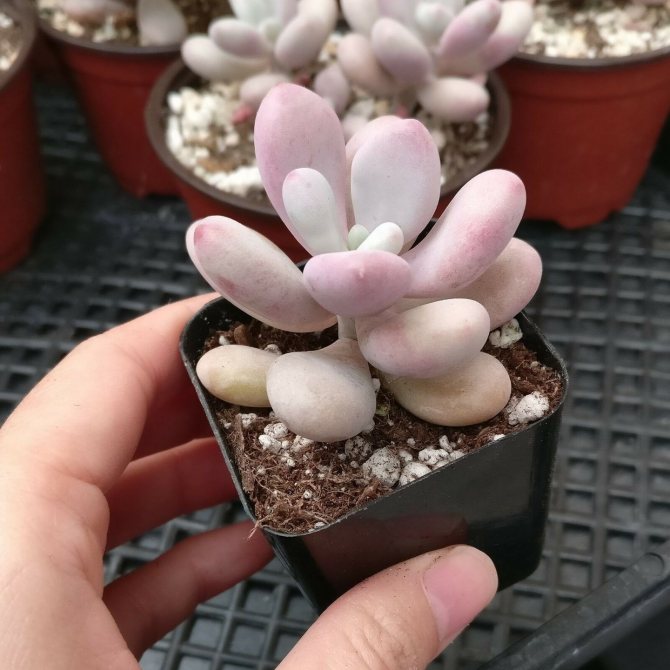

After purchasing pachyphytum in a store, it is advisable to transplant it into new soil. The procedure is carried out 2-3 days after purchase, when the plant adapts to new conditions. In the future, transplantation into new soil and a pot of larger diameter is carried out in the spring, when the succulent has not yet left the state of winter dormancy.
The size of the pot is calculated in such a way that between its walls and the root system there is a space of no more than 1 cm. It is impossible to plant pachyphytum in a large container immediately: the soil that has not been developed by the roots will acidify.
The plant is moved to a new container by the transfer method, along with a clod of earth. Drainage is laid at the bottom of the pot, the extracted earthen lump with the plant is placed on it, and the remaining space is covered with a light substrate. Soil composition for pachyphytum:
- leaf and sod soil - 1 part each;
- sand - 0.5 parts;
- brick chips or small gravel - 0.5 parts.
When transplanting, you need to gently touch the leaves of the plant. If the dusting is erased from them, the pachyphytum may dry out.
Does the plant need support
The stem of the pachyphytum is strong and does not need support during cultivation. Elongation is observed in old plants, because as they grow, the leaves fall from the lower part. Such specimens lose their decorative effect, so the tops are cut off and rooted in the soil.
Chlorophytum herbaceous bush
Chlorophytum is a perennial herb with green or white-green narrow leaves, hanging airy whiskers with small bushes of new plants on them in many homes.
The homeland of the flower is South Africa, where it grows like an epiphyte on the bark of trees. Previously, it was attributed to the Liliaceae family; among modern studies there is no consensus regarding the place of this genus. According to some data, the genus belongs to the Asparagus family, according to others, to the Agave family. In Europe, the flower began to be cultivated only in the 19th century.
As you can see in the photo, with decent home care, chlorophytum reaches up to 50 cm in diameter and the same height:
Long leaves are green, pale green with white or creamy longitudinal stripes. From the center of the bush cascade shoots up to 80-100 cm long with small leaves and flowers. Flowers are small white stars at the ends of long shoots, which then turn into leafy rosettes with aerial roots.
Next, you can familiarize yourself with the description and photo of chlorophytum species, as well as flower care at home and pest control.
Description
| Pachyphytum Oviferum, the “Sugaralmond plant” (also poetically named “Moonstones”). The egg-shaped leaves are covered with a blue-white bloom which marks if the leaves are rubbed. Easy to flower and easy to grow, it is a favorite of many hobbyists. Family: Crassulaceae Scientific Name: Pachyphytum oviferum J. A. Purpus Origin: Northern Mexico. Habitat: Often found clinging on steep cliffs in crevices on the rocks. Synonyms: Pachyphytum ovatum Common English Names include: “Moonstones”, “Pearly Moonstones”, “Sugar Almond plant” Etymology: The genus name Pachyphytum comes from the Greek “pachys (παχυς)” = “thick, fat” and “phyton (φυτον)” = “plant, tree” and implies ‘Fat plant’. The name oviferum, was given because its leaves resemble flattened eggs (from Latin “ovum” = “egg” and Latin “fero” = “to bear, carry, bring”)
| |
| Description: Small to medium-sized slow-growing Mexican member of the succulent family Crassulaceae, it has characteristic loose rosettes with ‘silvery globes’ leaves. It grows in both shrub-forming and almost stemless rosettes and eventually forms dense clumps up to 20-25 cm tall and 30 (or more) cm in diameter. Several forms exist but the more popular is the round, egg-shaped leaf form. Pachyphytum rosettes will not die after flowering (polycarpic, versus monocarpic) .Stem: Short, prostrate, greenish to whitish.Leaves: Up to 5 cm long and 3 cm wide, closely packed together, extremely smooth, plump and fleshy, obovate, grape -shaped, ± flattened spoon-like or tubular often reminding of Sugar almond. Range in color from ghostly silver blue-green with a pearly shine to lovely pinkish blue, orange and even purple and may have a dense white powdery coating called farina, these characters preserve moisture and protect from strong sunlight.Flowers: Up to 7-15 flowers grow on a 8-15 cm long arching, spikey inflorescences. They are small, pendant, bell-shaped, about 1 cm long, the outer is greenish-white and the petals are cream-colored to deep red-orange. Blooming season: Winter to early spring. | |
| |
|
|
|
|
| The Pachyphytum are fascinating plant because not only look exceptional but also produce unusually beautiful inflorescences. Truly beautiful! Cultivation: These plants are fairly hardy, and are common houseplants, they will require a free draining compost. Needs regular water in summer, but reduce watering during winter month, fairly drought tolerant elsewhere. They love full sun, with some shade during the hottest part of the day. A good light exposure helps to keep the plants compact and encourage leaf color and flowering. The white pruinose stem coatings of the plants in our collection sometime is not so intense as those of the plants in their natural habitat but the difference in coating is thought due to the higher humidity and less intense sunlight of our climate. However, like Graptopetalum and Echeveria, pachyphytum is sensitive to being handled, as skin oil can damage leaves, in particular those with a pearlescent colouration or farina.After growing for several years tend to become untidy, and should be cut very short or restarted from cuttings. Frost Tolerance: Hardy to -7 ° C. Pachyphytum are sensitive to mealybugs. Propagation: Cuttings, seeds. New plants can be also propagated from orphaned leaves. |
General description of the genus with a photo
Pachyphytum is a genus of succulent plants from the Tolstyankov family. A common feature of all its basic varieties are thick, very juicy leaves of small size and rounded shape. It can vary in different species from almost round ovoid to flat or faceted. Their color varies in the range of light gray, gray-blue, pale green and dim purple. From above, the leaves are covered with a light waxy bloom, which further mutes their base color.
In size, the pachyphytum is a fairly compact plant, its shoots rarely reach 30 cm, for the most part they are much shorter, have short internodes. The formation of new leaves occurs in a spiral, and due to their very dense arrangement, outwardly they create the impression of a whorled type of arrangement.The exception is long-leaved pachyphytum.
Main types
Pachyphytum oviferous (Pachyphytum oviferum)
Also called "moonstone" - this is the most popular type among flower growers. Shoots can be 20 centimeters long and 1 centimeter wide. The lower surface of the branches is bare and there are scars on it that remain from fallen leaves. Bluish-gray leaves with a pink tint are obovate. In length they reach 5 centimeters, in width - 3 centimeters, and have a thickness equal to 1.5 centimeters. The plant blooms in July – September. The length of the peduncle is 20 centimeters. The spike-shaped inflorescence consists of whitish-green flowers with a pinkish speck. Their blooming occurs gradually, while it begins from the bottom of the inflorescence. Sepals are bluish-white.
Pachyphytum bracteosum
It is also quite popular with flower growers. In length, the shoots can reach more than 30 centimeters, while their width is only 2 centimeters. Elongated leaf plates are flatter than the previous type. They are found only on the upper part of the shoot, and that's all, because after a while the adult leaves fall off. In length, the leaves reach 10 centimeters, in width - 5 centimeters and have a centimeter thickness. The leaves are silvery-white in color, with a strong bloom of wax on the surface, which casts a little pink in bright sunlight. Flowering is observed in August – November. The peduncle reaches a height of 40 centimeters. The flowers are red.
Read also Dream interpretation bouquet of blue flowers
Pachyphytum compactum
This miniature plant has the most spectacular appearance of all species. Its shoots are no more than 10 centimeters long. Obovate leaflets have pointed tips. Their length can be up to 4 centimeters, while the width and thickness are equal to 1 centimeter. The leaf plate is colored dark green, while on its surface there are pale gray waxy stains, due to which a marble pattern appears. Outwardly, they are similar to the kidneys of a rather large size. The entire surface of the shoot is covered with leaves. In this case, only the oldest parts of the stems are bare. In springtime, rather thick peduncles grow, reaching 40 centimeters in length. On each of the peduncles there can be 3-10 orange-red flowers, while the tips of the petals are bluish. Sepals are colored pink or green. It happens that the tips of old leaf plates become reddish.
Pachyphytum is a perennial succulent from the Fat family. The plant got its name from the Greek words "groin" - thick and "fitum" - leaf. The distribution area is the south of America, Mexico.
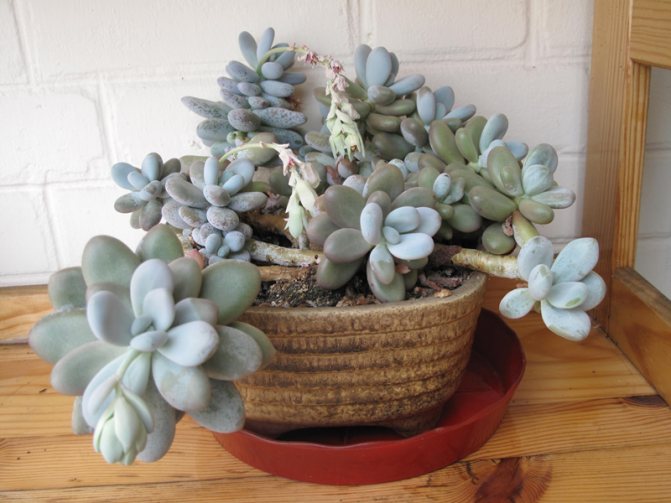

Problems in the cultivation of pachyphytum
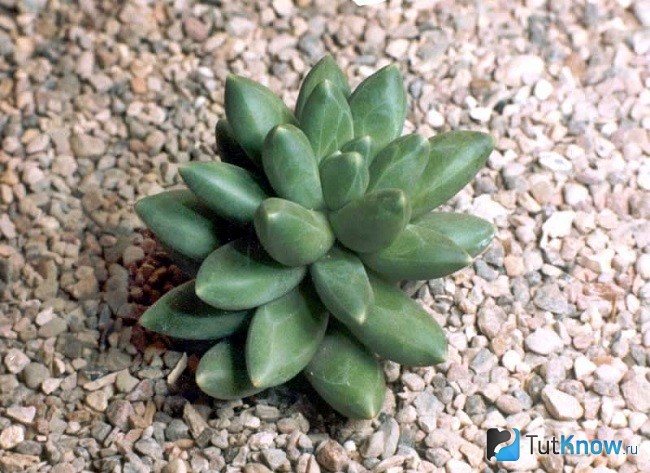

This plant is practically not interested in pests, only occasionally a mealybug defeat can occur. In the axils of the leaf plates, a whitish bloom appears, resembling pieces of cotton wool. It can be carefully removed with a cotton swab wound around a match and moistened with any alcohol solution (for example, a pharmacy calendula tincture). To combat the pest, treatments with modern insecticides are also used.
Most of the problems in the cultivation of pachyphytum occur due to violations of irrigation regimes and high environmental humidity. If the leaf plates began to deform, wrinkle or fade, then this indicates too much drying of the earth in the flowerpot. If the temperature is lowered, and the plant is very moisturized, then this can lead to rotting of the succulent root system. When the shoots began to stretch ugly, and the leaf plates are rarely located or their size is smaller and the color shade turns pale, then it is necessary to transfer the pachyphytum pot to a more illuminated place.
Containment Procedures: Table
The conditions for keeping and caring for the plant depend on the season.
| Season | Lighting | Humidity of air and soil | Temperature |
| Spring Summer | Bright, but not in direct sunlight. | Moderate, on hot days it is necessary to ventilate the room or keep the plant on the balcony, street. | 20-26 degrees Celsius. The plant is able to withstand a short-term temperature rise of up to 30-35 degrees. |
| Autumn winter | Moderate. | Low, in a cool room, watering is not carried out in winter. | About 16 degrees, it can be slightly lower, but not less than 10, otherwise the flower will freeze or begin to rot. |
Reproduction methods
Reproduction of spathiphyllum by cuttings
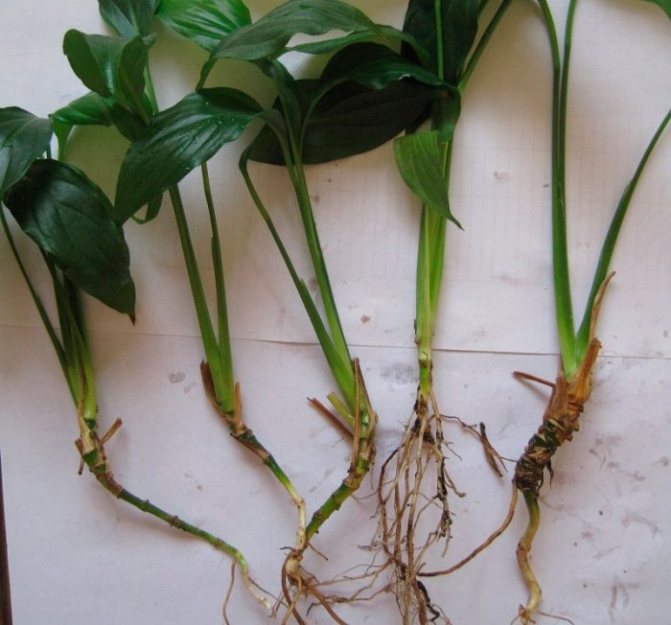

For rooting cuttings of spathiphyllum, it is recommended to use moistened sand. They need warmth (at least 22 degrees). After the cuttings grow roots, they are planted in individual pots filled with a soil mixture consisting of leafy, peat and turf soil, and also sand (2: 2: 1: 1).
Reproduction of spathiphyllum by division
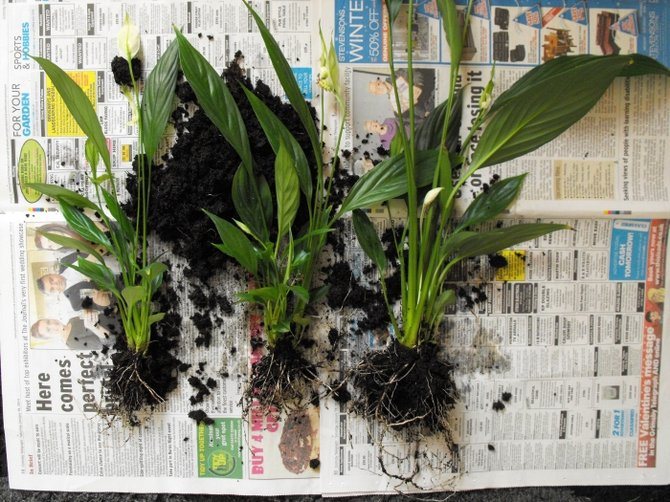

During transplantation in spring, if desired, the flower is propagated by dividing the root. Young points of growth are formed at the shortened stem, and new leaf plates appear from them. If necessary, divide the root into several parts, while on each division there should be 2 or 3 leaf plates and one growth point. The division is carried out in warmth (approximately 21 degrees). For planting delenok, pots are used, reaching 15 centimeters in diameter, as well as a soil mixture consisting of peat, sand, humus and leafy soil (2: 1: 2: 2), and you also need to add a few pieces of brick, charcoal and bark to it ... You can also use a substrate of coniferous and leafy soil, peat, sand and humus (2: 2: 2: 1: 2). And a soil mixture of leaf, peat, coniferous and humus soil, as well as sand (2: 4: 1: 1: 1) is also suitable. It is recommended to add a small amount of charcoal to it.
Possible problems
Spathiphyllum does not bloom
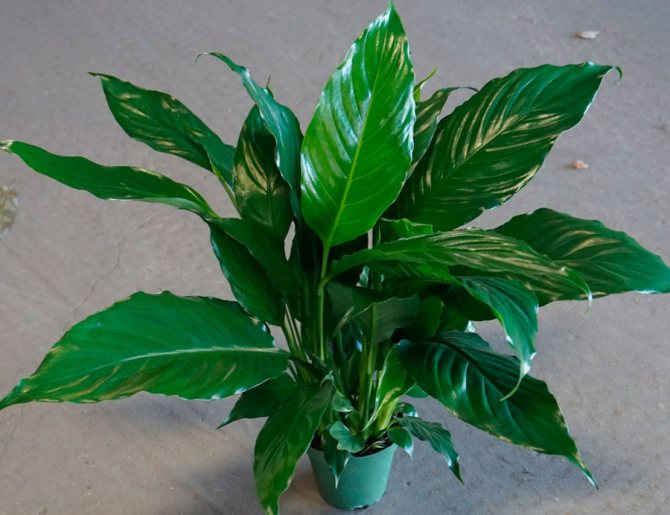

There are several reasons for this. Flowering problems are usually associated with low temperatures and insufficient humidity. Spathiphyllum will not bloom if it is not fed with mineral and organic fertilizers. In addition, old spathiphyllums rarely bloom.
Leaves turn black
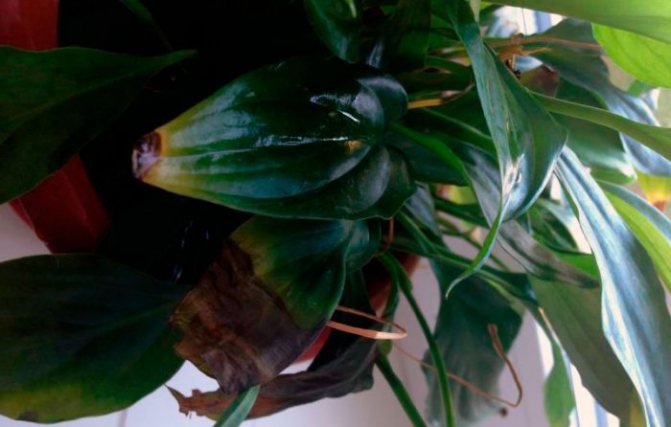

Blackness on the leaves indicates the death of the root system. Most often, this problem is associated with improper watering. Leaves can turn black both when underfilling and when overflowing. Black leaves can also appear with a lack of phosphorus and nitrogen. Remember not to spray the plant in a cold room. To save the flower's life, it should be removed from the pot and new roots removed, and then transplanted into a container with a new earthen substrate.
Leaves turned yellow
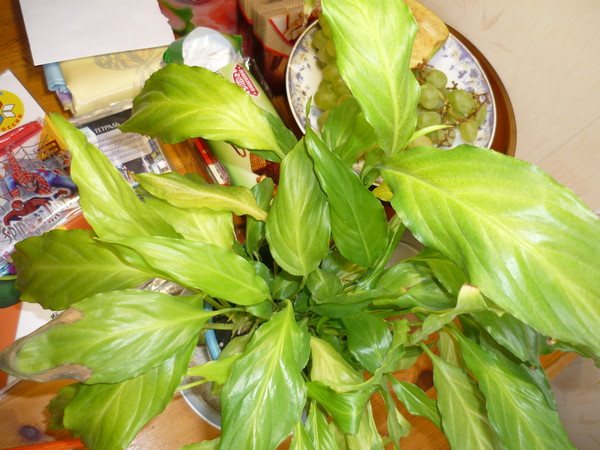

Dried and yellowed leaf tips indicate underfilling. To fix this problem, the plant needs to have a weekly bath. This procedure will help to cope not only with yellowness on the leaves, but also protect the flower from pests. If you haven't watered the plant for a long time, you can save it. But you should not immediately pour water on the flower. After soaking dry soil, the amount of water is gradually increased. Spathiphyllum can fade even with insufficient moisture. In this case, spraying and wiping the leaves will help. The plant can be placed in a pallet with damp expanded clay. Also, yellowness can appear if the flower is attacked by pests.
Pests
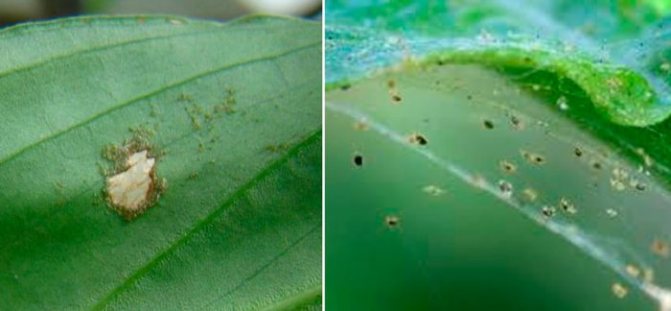

The main pest for spathiphyllum is spider mites and aphids. To get rid of them, the plant should be wiped with a soapy solution with nicotine sulfate. Only when treating against parasites should the earthen cover be covered with a film, the liquid should not get into the soil. If you regularly wash and wipe the leaves of the plant with a damp sponge, you can forget about pests forever.
Pachyphytum description
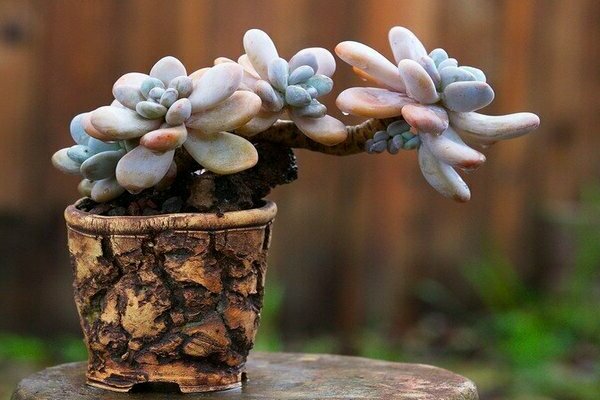

This genus of plants belongs to the Tolstyankov family. The plant contains 10 species, and they all belong to succulents.The homeland of these plants is considered the territory of Mexico. All that these plants have in common are fleshy and juicy thick leaf plates. Their shape and size are sometimes very similar in appearance to a flat grape berry. The color of the leaves is gray with a green tint. There is a pronounced white bloom on the surface. Pachyphytum has its name from the Greek language, which, if translated, means "thick-leaved".
Pachyphytum has a very small size. Its stems are creeping and, as a rule, do not exceed 30 cm in length. The internodes in plants are also small. The leaves grow in a spiral around the stem, and due to the short internodes are very close to each other. Therefore, if you do not look at them very closely, you might think that they are collected in whorls of several pieces.
Pachyphytum peduncles are long. During the flowering period, they grow from the top of the plant, differ in small inflorescences that are formed in the form of a spikelet. The plant does not bloom profusely. Each flower has five drooping petals and resembles a bell shape. The shade of flowers can be pink or red. Around the flowers are sepals, which are very similar to the leaves of a plant, they are also covered with bloom.
After the flowering period, the fruiting period begins, and pods with some seeds are formed.
Name of species and their photos
The genus pachyphytum has about a dozen varieties, many of which are endemic to different regions of Mexico. Consider the most decorative species suitable for indoor growing.
Pachyphytum oviparous
It was this species that received the name "moonstone" for its specific appearance. It has a developed, but very thin root system and aerial shoots reaching 20 cm in length. Their width is usually no more than 1 cm. Gradually falling leaves leave noticeable scars in the lower part of the growing shoots. The color of the leaves is gray-bluish, "lunar", their shape resembles a chicken egg turned upside down, but of a smaller size. The maximum leaf length in an adult specimen is 5 cm. Flowering usually occurs in the second half of summer, but depends on conditions. Peduncles up to 20 cm high bear spike-shaped inflorescences of pale green buds with a slight pinkish speck with white-blue sepals.
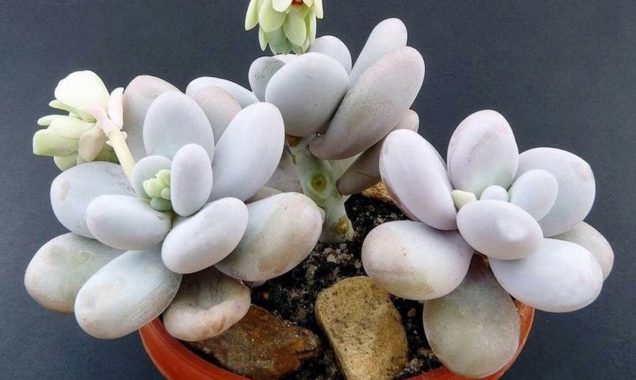

Pachyphytum bracts
Widely demanded variety in indoor floriculture. Shoots can exceed 30 centimeters in length with a width of about 2 cm. Compared to the previous species, the leaves have a flattened, non-circular shape, but in the same way they fall off as the stem grows. The color of the foliage is dominated by a white-green hue, more saturated than that of the egg-bearing species. When kept in the open sun, the leaves acquire a pink-lilac tint. Bloom lasts from August to November. Peduncles can be carried up to a height of 40 cm, flowers are reddish.
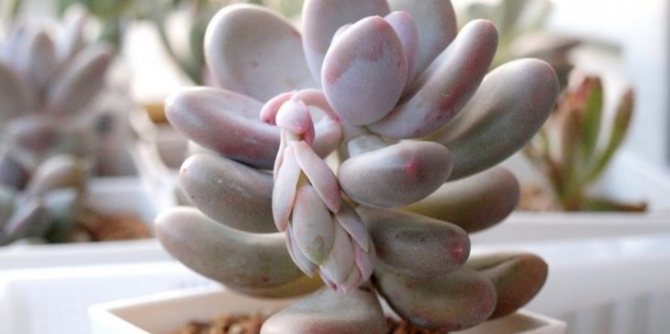

Pachyphytum long-leaved
This variety is less similar to pebbles than others, representing erect single rarely leafy shoots. Has a fairly large distance between alternately located leaves on short, straight stems. Leaves are elongated, strongly flattened, up to 7 cm long. Their color is light green with a slight purple tint. Bell-shaped flowers bloom on a high, straight peduncle, have a dark pink soft color.
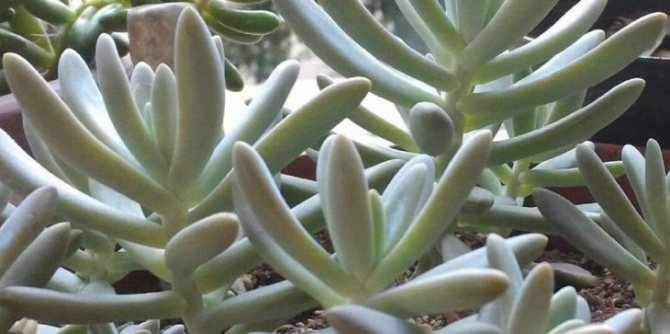

Pachyphytum compact
A miniature variety that can be called the most spectacular in its appearance. Stems are short, up to 10 cm, leaves are obovate, but not round, but consisting of many flat faces, pointed at the ends. Their length is about 4 cm. The general color of the foliage is muted green, with pale gray chaotic stains, which creates the effect of a marble pattern. Unlike previous species, only the lowest parts of the shoots become bare over time, which is almost imperceptible due to the dense arrangement of leaves with small internodes.Sufficiently fleshy peduncles begin to grow in spring, they are carried high up, sometimes reaching 40 cm. Up to 10 flowers of an unexpectedly bright orange-red succulent with bluish tips of petals can be released on them. The sepals can be green or pinkish in color. The tips of the leaves can be darker, especially in good lighting conditions.
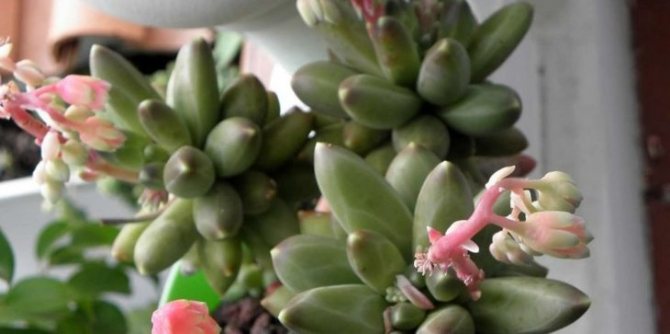

Description of the plant
Pachyphytum is a rhizome perennial. The root system of the plant is very highly branched, but the roots themselves are thin. A drooping or creeping stem with sparse aerial roots and lateral processes is located on the surface of the earth. The fleshy stems are very densely covered with sessile or short-petiolate leaves. The length of the stem can reach 30 cm. The leaves are grouped on the young parts of the shoot and gradually fall off at its base.
The leaflets are very thickened, they have a round or cylindrical shape. The end can be pointed or blunt. The leaf plates are colored green, bluish or dove-gray and appear to be covered with a velvet bloom.
From July to the end of September, the pachyphytum blooms. It produces a long, erect or drooping peduncle with a spike-shaped inflorescence. Miniature flowers in the form of five-petal bells are painted in white, pink or red. Sepals and petals also have a fleshy texture and velvety skin. Flowering is accompanied by a very delicate, pleasant aroma.
After flowering on pachyphytum, small pods with small seeds ripen. The setting of seeds is possible only in the natural environment; this process does not occur when grown at home.
How to propagate chlorophytum with rosettes
Reproduction of chlorophytum is carried out by rosettes formed on the peduncles and seeds.
Before propagating chlorophytum by offspring - (rosettes of leaves with roots), they are separated and planted in pots (it is advisable to use wide containers or bowls).
Practically propagated throughout the year, but usually the separation of young plants from maternal plants is carried out in late spring and summer, when young plants are formed on flowering shoots, preferably from 2-3-year-old mother plants. It is advisable to keep mother plants at a temperature of + 12-15 ° C (at a higher temperature, loose and weaker bundles of leaves with young roots are formed). It also reproduces easily by dividing a large plant.
When growing chlorophytums, several pots of soil are placed next to the pot (a mixture of meadow, leaf and humus soil and part of the sand). Lines are stretched into these pots, and each plant (a bunch of leaves with roots) is planted in a pot. When the plants are hardened, the lashes are cut from the mother plant.
It can also be propagated by seeds in spring, which germinate within 3–6 weeks under favorable conditions and at temperatures not lower than + 20 ° C.
2. Varieties:
2.1. Pachyphytum oviferous - Pachyphytum oviferum
Spectacular, miniature succulent, reaching a height of 10 cm with short, light stems, and bluish or light purple rounded, thick, succulent leaves, covered with a waxy bloom and collected in rosettes at the tops of the stems. Flowers are reddish-orange or greenish-yellow, appear in winter or early spring on apical peduncles up to 30 cm long.
Up in the menu
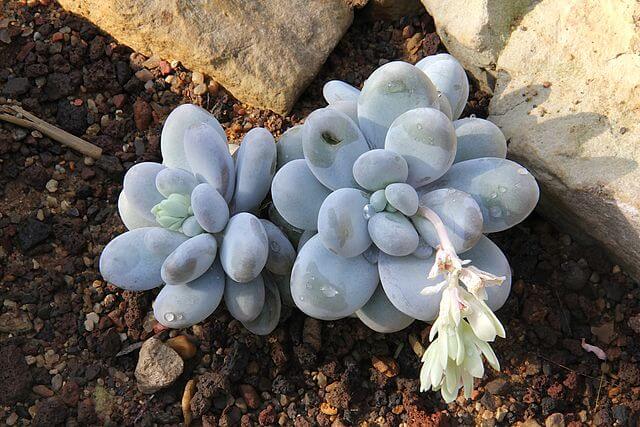

2.2. Pachyphytum bracts - Pachyphytum bracteosum
A charming succulent plant with creeping or erect stems 10 - 30 cm long and thick, fleshy, rounded leaves of bluish green, purple or pinkish shades. During the flowering period, thin leafless peduncles with small, attractive, greenish-red or yellow flowers appear at the tops of the shoots.
Up in the menu
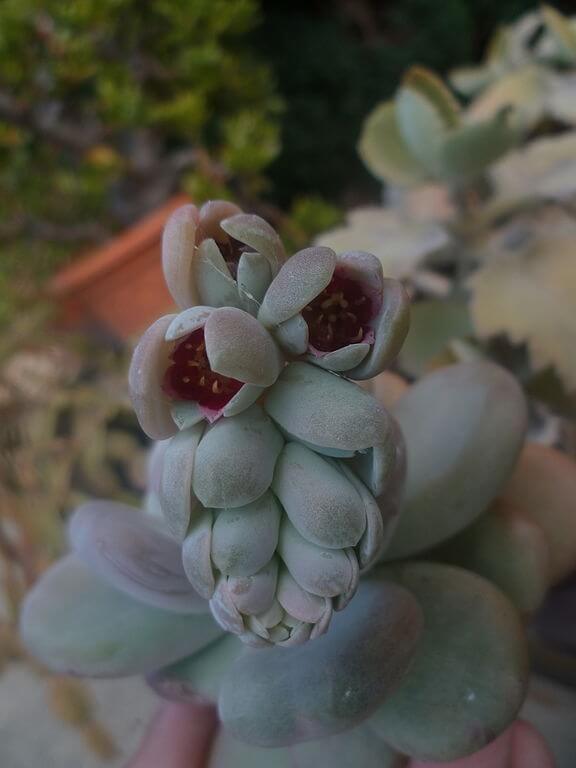

2.3. Pachyphytum compact - Pachyphytum compactum
An attractive evergreen succulent with short, erect stems and pointed, oblong, rounded leaves, collected in rosettes.The color of the leaves is predominantly light green with pinkish or burgundy tops. The leaf surface is often covered with a bluish waxy coating. Vertical peduncles bear small inflorescences with yellow or pink flowers on the tops.
Up in the menu
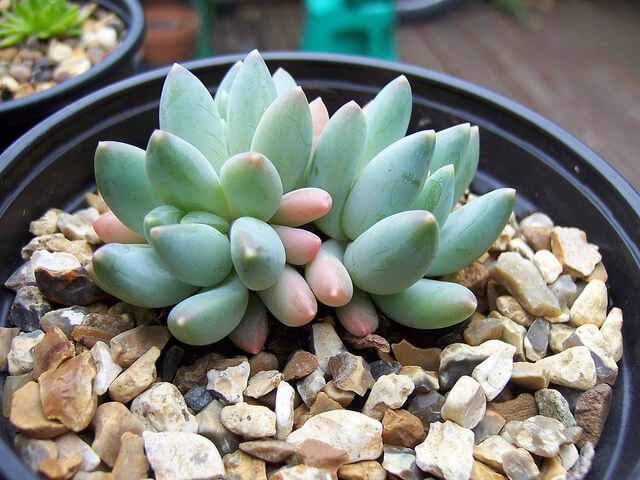

2.4. Pachyphytum Verderman - Pachyphytum werdermannii
Miniature succulents with low stems, on which light green or bluish leaves collected in whorls are located. The leaves are thick, juicy, oblong - oval, covered with a bluish waxy bloom. The upright leafless peduncles during flowering bear small drooping inflorescences with charming greenish-red flowers on the tops.
Up in the menu
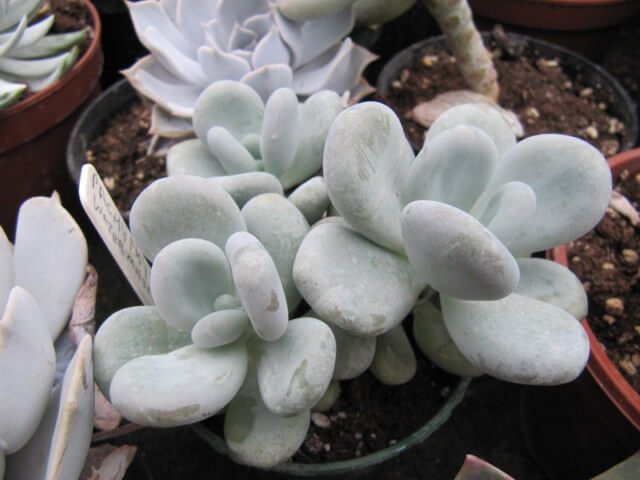

2.5. Pachyphytum glutinicaule - Pachyphytum glutinicaule
Young plants represent basal leaf rosettes of bluish, oblong leaves. With age, this variety forms thick, erect stems. Peduncles are thin, leafless, pinkish. The inflorescences consist of several attractive pink, drooping, bell-shaped flowers.
Up in the menu
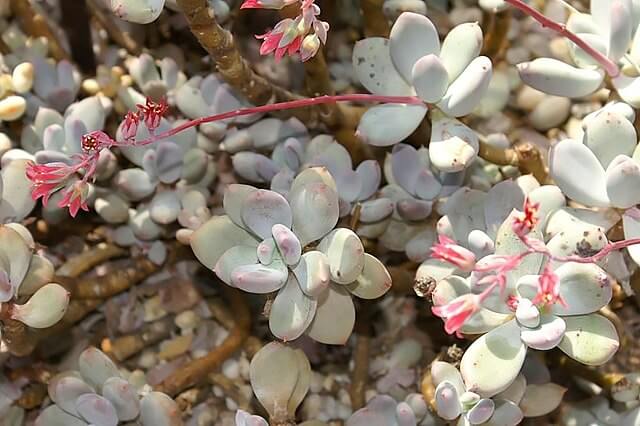

You may also be interested in:
Pachyphytum is a compact indoor flower with thick fleshy leaves, most often of a bluish-greenish color, covered with a whitish waxy coating. It was the voluminous leaves that gave the name to the plant: pachyphytum in ancient Greek sounds like a "thick leaf" - the leaves look like a slightly flattened drop. Pachyphytum is native to the arid regions of Mexico.
The genus Pachyphytum belongs to the Crassulaceae. Like all succulents, the leaves store moisture and the plant can survive a slight drought.
All indoor varieties are small in size. The stem of the flower is drooping or creeping, up to 30 cm long. There are few branches at the stem, it is densely covered with fleshy leaves on short petioles or without them.
The leaves grow in a spiral, the old ones crumble from the base of the stem, the stem is bare, and a few aerial roots become visible. The leaves are round in shape, with obtuse, occasionally with pointed tips. A branched system of small roots extracts moisture well from the soil.
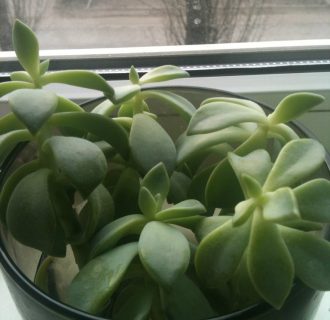

The flowering time of pachyphytums is from spring to autumn. The inflorescence is a fragrant spikelet with miniature velvety bells in colors ranging from white to red.
Care errors and methods of correcting the situation: table
Violation of the rules for caring for a succulent and its conditions leads to growing problems.
| Signs of a problem | Cause | Remedy |
| Deformation and wrinkling of leaves | Lack of moisture in the soil and air. Most often this happens in summer, in extreme heat. | Regular soil moisture. |
| Brown spots on the leaves | Root decay due to waterlogging. | The plant is transplanted into new soil, watering is reduced, and the room is ventilated more often. |
| Pulling shoots | Lack of lighting. | The plant is placed on a well-lit windowsill. In winter, they illuminate with lamps. |
Photo
"Moonstone" - pachyphytum:
1. Seven Secrets of Success:
| 1. Growing temperature: during the active growth period of the year, this thermophilic plant is kept at a temperature of 18 - 27 degrees Celsius. In the winter months, a cool dormant period sets in, which the pachyphytum should spend at a temperature of about 10 degrees Celsius. |
| 2. Lighting: in the morning and in the evening - direct sunlight, in the daytime in spring and summer, light shading will be required. |
| 3. Watering and humidity: Water abundantly in spring and summer, but dry a few centimeters deep between waterings. In the fall and winter, keep watering to a minimum. The air humidity should not be increased. |
| 4. Features of the: for all its attractiveness, pachyphytum is unpretentious and this flower can be safely recommended to novice growers - it is afraid only of abundant and frequent watering. |
| 5. Priming: loose, nutrient-poor substrates with slightly acidic pH and excellent drainage. |
| 6. Top dressing: In spring and summer, feed once a month with liquid mineral fertilizers for succulents or cacti. In the middle of autumn, feeding is stopped and resumed only in the spring. |
| 7. Reproduction: propagated vegetatively - by means of leaf cuttings or generatively - grown from seeds sown in spring. |
Botanical name: Pachyphytum.
Family... Crassy.
Origin... South America, Mexico.
Description... Pachyphytum is a genus of miniature, perennial succulent plants, consisting of 12 species. Plants form a leaf rosette up to 30 cm in diameter, consisting of fleshy, rounded or oblong, succulent leaves up to 5 cm long. The color of the leaves is very diverse and includes light green, gray, purple, pink, blue, orange shades. Some species have a waxy coating on the leaves. During the flowering period, in spring and summer, the plants emit very tall leafless peduncles, at the top of which are branched inflorescences with many drooping greenish or pink flowers about 1 cm in diameter.As the plants age, they form short, thick stems.
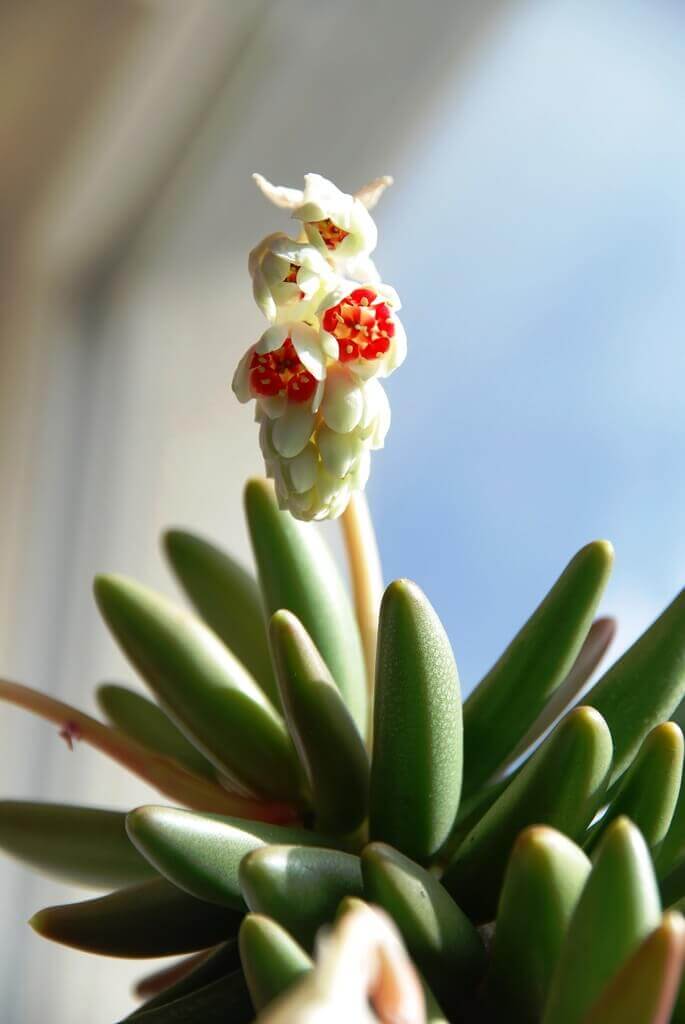

Height... 20 - 25 cm, growing slowly.

